CA Foundation Economics – Theory Of Demand And Supply
Law Of Demand And Elasticity Of Demand
Demand
The desire to have a commodity backed by purchasing power at a particular price in a particular period is known as Demand.
Demand. per commodity refers to the amount of the commodity that consumers are willing and able to purchase at a particular price in a particular period/-
Types of Demand:
- Individual and Market Demand: –
- The quantity of a commodity that .an individual consumer is willing to purchase at a given price during a given period is known as Individual demand.
- The total quantity of a commodity that all the consumers are willing to buy at a given price during a given period.
- Ex-ante and Ex-post Demand:
- Ex-ante demand refers to the amount of goods the consumers want/are willing/plan to buy during a particular period.
- Ex-post demand refers to the amount of goods that consumers purchase during a specified period.
- Ex-ante demand can be less more or equal to ex-post demand.
- Joint Demand:
- It refers to the demand for two or more goods that are used jointly or demandedtogether.
- Example: Car and petrol pen and ink mobile and SIM card.
- Derived Demand:
- The demand for a commodity arises because of the demand for some other commodity. .
Example: Steel bricks and Cement are derived from houses or other buildings. All the factors of production are derived from demand.
- The demand for a commodity arises because of the demand for some other commodity. .
- Composite Demand: Demand for goods that have multiple uses is called multiple or composite demands..
- Example: Electricity and Milk.
Factors Affecting Demand:
- Price of the commodity: When the price of the commodity increases the demand decreases and . when the price of the commodity decreases the demand increases. Price and demand are inversely related. This type of demand is known as price demand.
- P ↑ Increases D ↓ Decreases
- P ↓ Increases D ↑ Decreases
- Price of related goods (also known as cross demand): Related goods can be classified into two kinds
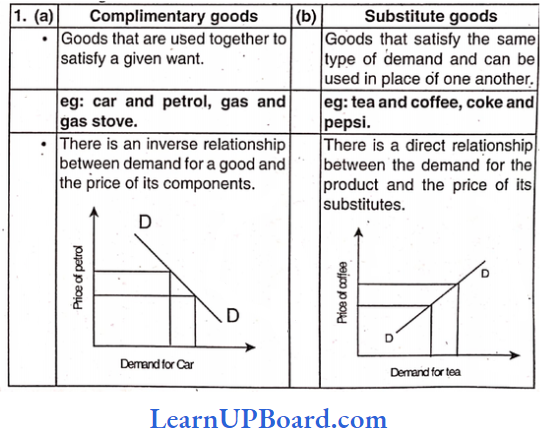
- Consumers’ Taste and Preferences: Taste and preferences depend on social customs and the habits of the people fashion and the general lifestyle of the people etc. if taste and preferences are strong for the product demand increases and if taste and preferences are weak and unfavourable for the product demand decreases.
- Consumer Expectations regarding price in the future: If the consumer expects an increase in price in the future demand increases in the present. If the consumer expects a decrease in the price in the future demand decreases in the present.
- Consumer credit facility: If credit facility to consumers is available demand increases. If credit facility to consumers is not available demand decreases. .
Ex: Car loans are easily available in India that’s why there are so many cars in India. - Income of the consumer: The relation between the income of the consumer and
The demand can be understood by taking three types of commodities:
- Normal goods: Goods for those the demand increases with the increase in income of the consumer and decreases with the decrease in income of the consumer.
- Examples: Furniture Television and clothes.
- Inferior goods: Goods for those the demand falls with an increase in the income of the consumer and rises with the decrease in the income of the consumer. There is an inverse relationship between the income of the consumer and the demand for inferior goods.
- Example: Maize and Bajara
- Inexpensive goods of necessities: Goods for those the demand increases with an increase in income up to a certain level and thereafter it remains constant irrespective of the level of income.
- Example: Salt and Matchbox
Factors Affecting Demand:
- Size and Composition of Population: The population size of a country determines the number of consumers.
- With an increase in the size of the population, the demand for the commodity will increase.
- The composition of a population refers to the various aspects of the population like the number of children adults males females etc. If the number of teenagers increases the demand for those goods that teenagers tend to buy increases.
- Example: Jeans cricket bat will tend to increase.
- Government Policy: If the Government increases indirect taxes it leads to an increase in price and as a result, the demand decreases.
- If the government incurred more expenditure on the construction of roads bridges etc.
- The demand for construction goods will increase.
- Distribution of Income:
- Case 1: If income is distributed evenly there will be more demand for essential goods.
- Case 2: If income is distributed unevenly then there will be more demand for luxury goods.
Demand Function:
.
The functional relationship between the demand for a product and its factors is known as the demand function.
Law of Demand
It states that other things remain constant the quantity demanded of the commodity increases when its price falls and decreases when its price rises. The law of Demand explains the inverse relationship between price and quantity demanded.
Assumption of Law of Demand:
- The price of related goods is kept constant.
- The prices of the commodities are kept constant.
- Consumers’ tastes and preferences are kept constant.
- Consumers’ expectations regarding prices in the future are kept constant.
- Consumer credit facility.
- The income of the consumers is kept constant. s
- Size and composition x>f the population are kept constant.
- Government Policies are kept constant.
- The distribution of Income is kept constant.
Exception to the Law of Demand:
- Articles of Snob Appeal (Conspicuous Consumption): The Law of Demand does not apply to the commodities that serve as a status symbol increase social prestige and is a source of display and richness.
- For example: Rich women would like to buy a diamond at a higher price to show their richness.
- Giffen goods:
- Giffen goods are those inferior goods on which consumers spend a large part of their income.
- Demand for this falls with the fall in their prices.
- Example: Maize and Jawar.
- Expectations regarding future price:
- If the price of a commodity is rising today it is likely to rise more in the future then people demand more at their existing higher price and store it up. . .
- Similarly, when the consumer anticipates a large fall in the price of the commodity in the future they will postpone their purchase even if the price falls today. .
- Quality price relationship:
- Sometimes consumers take price as an index of quality in such cases more of the goods may be demanded at a higher price.
- This is known as the Veblen effect.
- Example: Like Lux Premium there is not much difference between Lux Premium and Lux International but a huge price difference. But people think that Lux International is better as it has a higher price.
- Change in fashion: When a commodity goes out of fashion consumers will not demand even when its price is reduced.
- Emergency: The law of Demand may not hold good during emergencies like wars famines droughts etc.
- Habitual goods: If the price of habitual goods increases demand does not decrease. Example: Cigarettes Wines.
Law of Demand Schedule
It is a tabular statement that shows different quantities of commodities demanded at different prices during a given period.
It is of two types:
- Individual demand schedule: It is the table that shows various quantities of the commodities demanded at different prices by a household/single consumer during a given period.
- Market demand schedule: It is the table that shows various quantities of commodities demanded at different prices by all the households in a market during a given period.
Individual demand schedule:
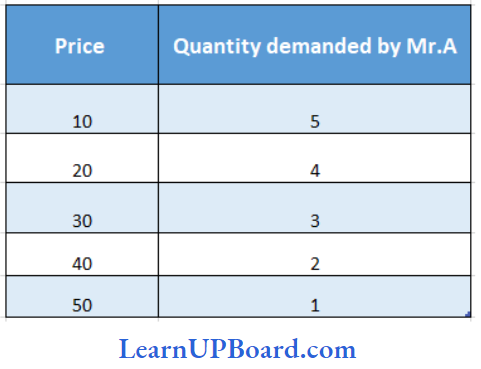
Market Demand Schedule:
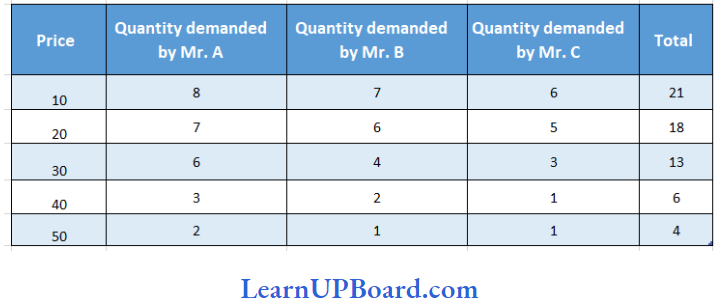
Law of Demand Curve
It is a graphical representation of different quantities demanded at different price levels.
1. Individual Demand Curve:
A graphical representation of different quantities demanded at different price levels by a single consumer.
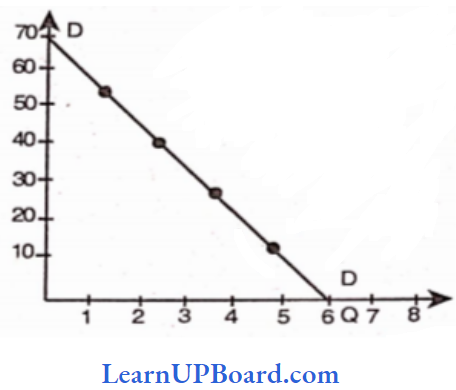
2. Market Demand Curve:
A graphical representation of different quantities demanded at different price levels by all the consumers in a market.
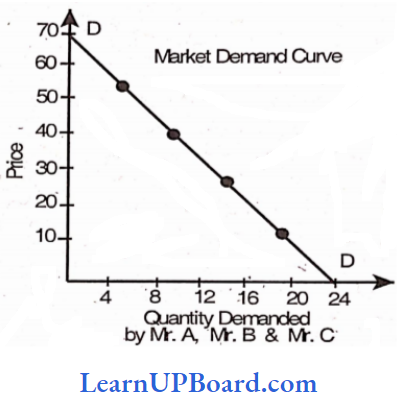
Reasons for Negatively Sloping Demand Curve:
1. Income Effect:
- A change in demand on account of a change in real income resulting in a change in the price of the commodity is known as the income effect.
- When the price of the commodity falls it results in an increase
- in purchasing power and the consumer can buy more and feel BETTER OFF”. –
- On the other hand with an increase in price purchasing power decreases and the consumer reduces the demand and feels ‘WORSE OFF’
2. The Law of Diminishing Marginal Utility:
- The law of diminishing marginal utility states that with an increase in the units of a commodity consumed every additional unit of the commodity gives lesser satisfaction.
- Marginal utility falls with an increase in consumption.
- A consumer will maximize his satisfaction when MUn = Price i.e. equilibrium condition.
- If the seller wants to sell more he has to reduce the price of the. commodity.
3. Substitution effect:
- The substitution effect refers to the change in demand for a good as a result of a change in the relative price ofthe good in terms of other goods.
- Example: When the price of a good rises it becomes more expensive in terms of other goods in the market As a result consumers move av/ay towards its substitutes.
- When the price of the commodity falls and prices of the substitute remain unchanged it becomes relatively cheaper in comparison to its substitutes. As a consequence demand for a commodity will increase.
- Example: If the price of tea falls and the price of coffee remains the same then the demand for tea increases and the consumers will shift their demand from coffee to tea.
Price effect = Income effect + Substitution effect
4. Increase In the number of consumers:
- When the price of the commodity falls the number of consumers increases which increases the demand for the commodity.
- It happens because at a very high price only a few people can afford to buy that commodity and when the price falls people with less income will also be able to purchase that commodity.
5. Several uses of a commodity:
- When the price of commodities example. electricity and milk are very high they will be used for more important purposes only.
- And thereafter small quantity will be in demand but when the price falls these commodities will be put to less important uses also leading to an increase in demand.
- Example: Electricity will be used mainly for lighting purposes if the price is high and the electricity will
Difference between Movement along the Demand Curve and Shift in the Demand Curve.
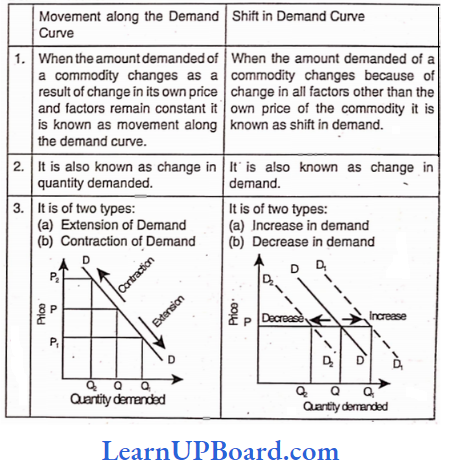
The difference between an Extension of Demand and an increase in Demand:
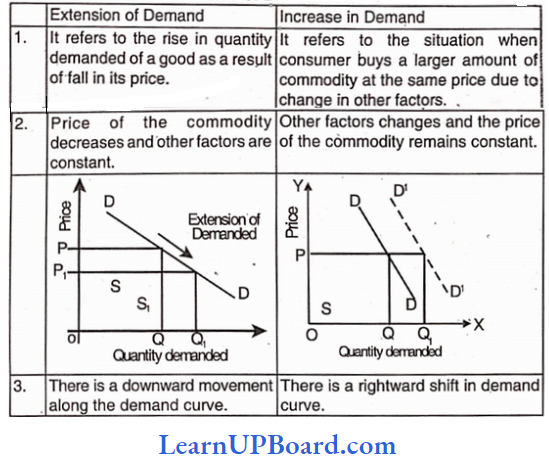
Difference between contraction of Demond and decrease in Demand:
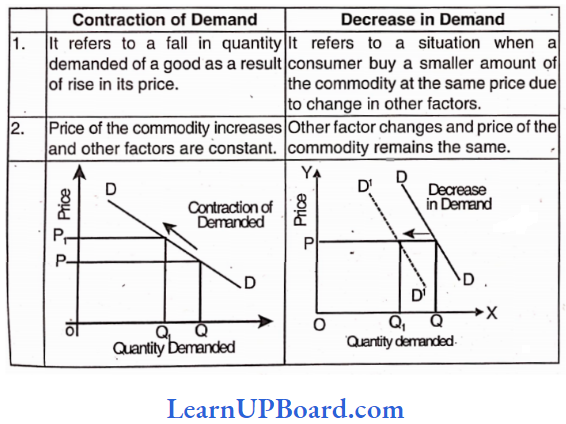
Elasticity of Demand
Meaning of Elasticity of Demand:
It refers to the degree of responsiveness of quantity demanded of a commodity to a change in any of its determinants.
Three main types of elasticities are:
- Price elasticity
- Income elasticity
- Cross elasticity
1. Price Elasticity
It refers to the degree of responsiveness of a quantity demanded by a commodity to a change in price.
Symbolically:
ep = \(\text { ep }=\frac{\text { Percentage change in quantity demanded }}{\text { Percentage change in price }}\)
Degree / Classification of Price elasticity:
- Perfectly elastic demand – ep = ∝
- Perfectly inelastic demand.- ep = 0
- Unitary elastic demand.- ep = 1
- Greater than one/more elastic demand ep > 1
- Less than one/less elastic demand.- ep <1
Perfectly Elastic Demand:
When consumers are prepared to purchase all that they can get at a particular price but nothing at all at a slightly higher price. The demand curve is parallel to the X-axis
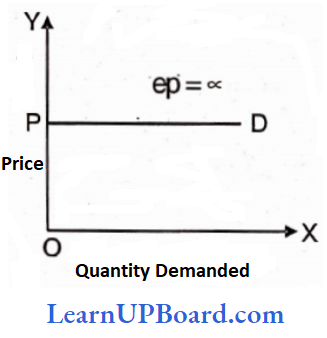
Perfectly Inelastic Demand:
When the quantity demanded of a commodity does not respond to a change in its price then the elasticity of demand is equal to zero. The demand curve is parallel to the y-axis.
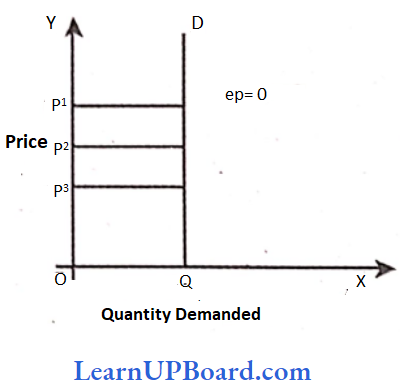
Unitary Elastic Demand:
When the percentage change in the price of a commodity causes an equivalent percentage change in quantity demanded. The demand curve is a Rectangular hyperbola.
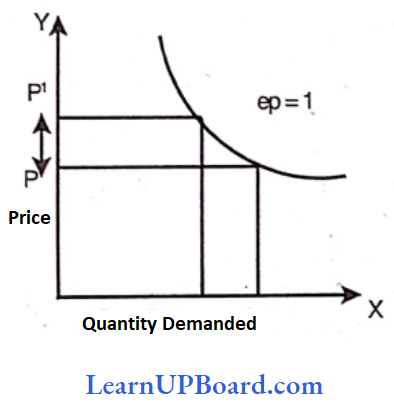
Greater than One/More Elastic Demand:
When the percentage change in quantity demanded of a commodity exceeds the percentage change in its price.
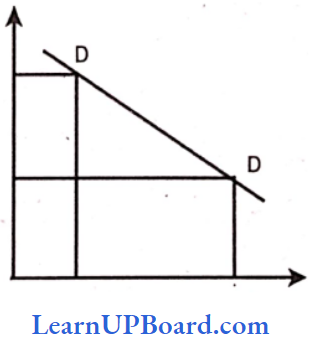
CA Foundation Economics – Theory Of Demand And Supply Multiple Choice Questions
Question 1. High-priced goods consumed by status-seeking rich people to satisfy their need for conspicuous goods” is:
- Veblen effect
- Bandwagon effect
- Snob effect
- Demonstration effect
Answer: 1. Veblen effect
Veblen effect was given by Veblen. Hence it is called the Veblen effect also known as the prestige goods effect. It is related to conspicuous consumption. Veblen effect takes place as some consumers measure the utility by its price i.e. if the price rises they think that the commodity has got more utility. Veblen effect is the behavior practiced by rich people to satisfy their needs for conspicuous goods.
Question 2.
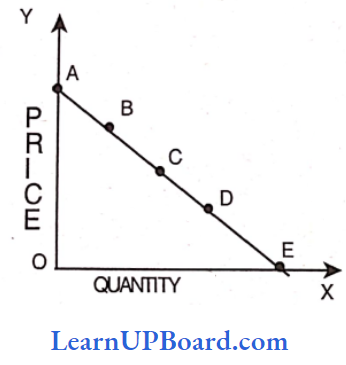
- Elasticity at point A = ∞ at B = > 1 at C = 1 at D = < 1 and at E = 0
- Elasticity at A=0 at B = < 1 at C = 1 at D = > 1 and at E = ∞
- Elasticity at A = 0 at B > 1 at C = 1 at D = < 1 and at E = 0
- None of these.
Answer: 1. Elasticity at point A = ∞ at B = > 1 at C = 1 at D = < 1 and at E = 0
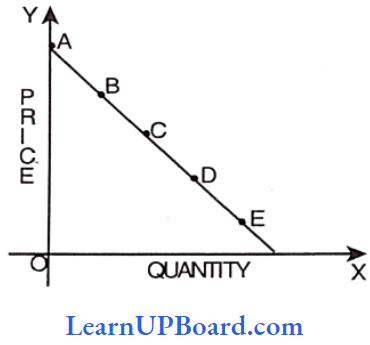
- When a change in demand is greater than the price change then e > 1
- When a change in demand is less than the price change then e < 1
- When a change in demand is the same as the change in price then it is e =1
- When there is no change in demand as a change in price then e = 0
- When the price changes slightly but demand change is higher then
Here C shows e = 1 by which we can prove that
C ⇒ e = 1, A ⇒ e = ∞, B ⇒ e≥1
D ⇒ e<1, E ⇒ e = 0
Question 3. The cardinal approach is related to:
- Indifference curve
- Equi marginal utility
- Law of diminishing returns
- None of these.
Answer: 2. Equi marginal utility
Marginal Utility theory is given by Alfred Marshall. He assumes that the marginal utility theory is related to a cardinal approach which means we can measure the utility in terms of money. Marshall says Money is the measuring rod of utility”.
Question 4. An Increase in demand can result from:
- A decline in the market price
- An increase in income
- A reduction in the price of substitutes
- An increase in the price of complements.
Answer: 2.
Price and demand are inversely related as the price rises demand falls and vice-versa. But income and demand are directly related. _A rise in income increases the quantity demanded and fall in income decreases the quantity demanded.
Question 5. The cross-elasticity of perfect substitutes is
- Zero
- Negative
- One
- Infinity
Answer: 4. Infinity
The cross elasticity of perfect substitutes is infinity as the rise in the price of one good will cause a rise in the demand for its substitutes.
Example: If the price of the tea rises the demand for coffee rises as these two are perfect substitutes. The cross elasticity of complementary goods leads to zero.
Question 6. Supply is a concept.
- Flow
- Stock
- Flow and stock both
- Qualitative
Answer: 1. Flow
Supply refers to ‘the quantity of a good or service that consumers are willing and able to purchase during a given period. Supply is a concept as quantity supplied is so much per unit of time per day per week or year. It is regularly going on supply which means not only those goods which are sold but also those which are in stock.
Question 7. For what type of goods does demand to fall with a rise in income levels of households?
- Inferior goods
- Substitutes
- Luxuries
- Necessities
Answer: 1. Inferior goods
Inferior goods are the type of goods that are not of good quality and no one wants to consume these but circumstances force them – to consume them. If the income rises of households then demand for inferior goods goes down or elasticity for these goods becomes negative. .
Question 8. Which economist said that money is the measuring rod of utility?
- A.C Pigou
- Marshall
- Adam Smith
- Robbins
Answer: 2. Marshall
Marginal Utility theory is given by Alfred Marshall.. He assumes that the marginal utility theory is related to a cardinal approach which means we
can measure the utility in terms of money. Marshall says Money is the measuring rod of utility”.
Question 9. Elasticity between two points:
- Point elasticity
- Arc elasticity
- Cross elasticity
- None.
Answer: 2. Arc elasticity
When price elasticity is to be found between two prices or two points on the demand curve then it is not possible to know what price and
. quantity should be taken as the base. So we use the Arc elasticity method to know the base price and quantity.
Question 10. If an indifference curve is L-shaped then two goods will be
- Perfect substitute goods
- Substitute goods
- Perfect complementary goods
- Complementary goods
Answer: 3. Perfect complementary goods
When two goods are perfect complementary goods (e.g. printer and cartridge) the indifference curve will consist of two straight lines with a right between them which is convex to the origin or in other words it will be L-shaped.
Question 11. The concept of consumer surplus is derived from
- The law of diminishing marginal utility.
- The law of equal-marginal utility.
- The law of diminishing returns
- Engel’s law.
Answer: 1. The law of diminishing marginal utility.
Consumer surplus is a surplus that a consumer would.be willing to pay rather than go without a commodity over that which he does pay. The concept of consumer surplus is given by Marshall and it is derived from = what a consumer is willing to pay – what he pays.
Question 12. When the supply curve shifts to the right there is
- An increase
- Expansion
- Contraction
- Decrease
Answer: 1. An increase
When the supply curve shifts to the right due to a change in one or more factors other than the price of the commodity. When the supply curve shifts to the right we say that there is an increase in supply and when the supply curve shifts. to the left, we say that there is a decrease in supply.
Question 13. Short-run price is also called by the name of
- Market price
- Showroom price.
- Maximum retail price
- None of these.
Answer: 1. Market price
Short-run price is also known as the market price and it is determined by the temporary equilibrium between the forces of demand and supply.
Question 14. When the supply price increases in the short run the profit of the producer
- Increases
- Decreases
- Remains constant ” .
- Decreases marginally
Answer: 1. Increases
Supply and price are directly related as the supply increases price increases and as the price decreases supply decreases. So increase in supply price will increase the profits of the producer.
Question 15. When the price of a commodity increases what will be the effect on the quantity demanded?
- Increases
- Decreases
- No change
- None of these.
Answer: 2. Decreases
As per the law of demand other things being equal if the price of a commodity falls the quantity demanded of it will rise and if the price of a commodity rises its quantity demanded will fall.
Question 16. According to the law of supply change in supply is related to?
- Price of goods
- Price of related goods
- Factors of production.
- None of the above
Answer: 1. Price of goods
According to the law of supply change in supply is related to the price of goods. As other things remain constant the quantity of a good (produced and offered for sale) will increase if the price rises.
Question 17. In the case of inferior goods with a rise in the income of consumer’s demand for Giffen goods will ………..?
- Increases
- Decreases
- No change
- None of the above
Answer: 2. Decreases
In general cases, as consumer income rises they will prefer high-quality goods, and therefore demand for Giffen goods will decrease.
Question 18. In the case of necessaries, consumer surplus is?
- Infinite
- Zero
- Equals to one
- More than one
Answer: 1. Infinite
In the case of necessaries, the marginal utilities of the first few units are infinitely large. In such cases, the consumer surplus is always infinite.
Question 19. When the price of a commodity rises from 200 to ^ 300 and Quantity supply increases from 2000 to 5000 units find the elasticity of supply.
- 3.0
- 2.5.
- 0.3
- 3.5
Answer: 1. 3.0
When the price of a commodity rises from 200 to ^ 300 and Quantity supply increases from 2000 to 5000 units
⇒ \(\frac{\Delta q}{q} \times \frac{p}{\Delta p} \rightarrow \frac{3,000}{2,000} \times \frac{200}{100}\)
= 3.0.
Question 20. From the following data given below answer the question
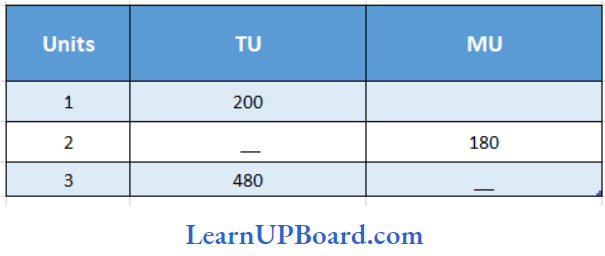
Total utility derived from 2nd unit:
- 380
- 20
- 100
- 280
Answer: 1. 380
TU = ∑MU
∴ 380
Question 21. The marginal utility of 3rd unit is?
- 200
- 280
- 100
- 50
Answer: 3. 100
MU = TUn – TUn-1
Therefore = 480 – 380
= 100
Question 22. Which Equation is correct
- \(\frac{M U x}{M U y}=\frac{P x}{P y}\)
- \(\frac{M U x}{M U y}>\frac{P x}{P y}\)
- \(\frac{M U x}{M U y}<\frac{P x}{P y}\)
- \(\frac{M U x}{M U y} \neq \frac{P x}{P y}\)
Answer: 1. \(\frac{M U x}{M U y}=\frac{P x}{P y}\)
The law of utility states that consumer equilibrium at the
⇒ \(\frac{M U x}{M U y}=\frac{P_x}{P_y}\)
Question 23. The scope of the indifference curve shows consumer equilibrium at the point where MRS(xy) = \(\frac{P x}{P y}\) (Price line)
- Less than
- More than
- Equal to
- None of the above
Answer: 3. Equal to
Question 24. Which of the following is not the property of the indifference curve?
- IC is convex to the origin
- IG slopes downwards from left to right
- Two IC can touch each other
- IC cannot touch either of the axes
Answer: 3. Two IC can touch each other
The properties of the Indifference curve are:
- Indifference curves slope downward to the right
- Indifference curves are always convex to the origin.
- Indifference curves can never intersect each other
- A higher. The indifference curve represents a higher level of satisfaction
- The indifference curve will not touch either axis.
Question 25. In the case of Normal goods rise in price leads to?
- Fall in demand
- Rise in demand
- No change
- Initially rise then ultimately fall
Answer: 1. Fall in demand
In general cases when the price of the commodities rise the purchasing power of customers will fall and therefore demand will fall.
Question 26. The method of demand forecasting does not include?
- Mathematical method
- Barometric method
- Expert opinion method
- Statistical method
Answer: 1. Mathematical method
Methods of demand forecasting are:
- Survey of buyers’ intentions
- Collection opinion method
- Expert opinion method
- Statistical method
- Controlled experiments
- Barometric method.
Therefore mathematical method is not a method of forecasting.
Question 27. If the price of the commodity increases what will be the effect on the quantity demanded?
- Decreases
- Increases
- No change
- Can’t say
Answer: 1. Decreases
As per the law of demand, other things remain constant when the price of a commodity increases quantity demanded decreases, and vice versa.
Question 28. An IC shows MRS between the commodities.
- Increasing
- Decreasing
- Constant
- Zero
Answer: 2. Decreasing
MRS is falling because as the consumer has more and more units of food he is prepared to give up less and Jess units of the commodity. –
Question 29. Forecasting of demand is the Art. and Science of predicting.
- Actual demand for a product at the same future date
- Probable demand in the future
- Total demand in the future
- None of these
Answer: 2. Probable demand in the future
Forecasting in general refers to knowing or measuring the status or nature of an event or variable before it occurs. Forecasting of demand is the art and science of predicting the probable demand for a product or a service.
Question 30. An addition made to total utility refers to the?
- Total utility.
- Average utility.
- Marginal utility
- All of the above.
Answer: 3. Marginal utility
Marginal utility is the addition made to the total utility by the consumption of an additional unit of a commodity.
Question 31. The elasticity of supply is zero means?
- Perfectly inelastic
- Perfectly elastic.
- Imperfectly elastic
- All of the above.
Answer: 1. Perfectly inelastic
The elasticity of supply:
- e > 1 ⇒ Elastic supply .
- e < 1 ⇒ Inelastic supply
- e = 0 ⇒ Perfectly inelastic supply
- – e = ∞ ⇒ Perfectly elastic supply
- e = 1 => Unit elastic .
Therefore the elasticity of supply is zero means it is a perfectly inelastic supply.
Question 32. The Consumer is in equilibrium when the following condition is satisfied:
- The budget line is tangent to the Ic curve
- \(\frac{M U_X}{P_X}=\frac{M U_Y}{P_Y}=\frac{M U_Z}{P_Z}\)
- Both (1) and (2)
- None of the above
Answer: 3. Both (1) and (2)
The condition for consumer attaining equilibrium is the point where the budget line is tangent to the indifference curve and \(\frac{M U_X}{P_X}=\frac{M U_Y}{P_Y}\)
Question 33. Which of the following statements is correct?
- Supply is inversely related to its cost of production
- The price and quantity demand of a good have a direct relationship
- Taxes and subsidies has no impact on the supply of the product
- Seasonal changes have no impact on the supply of the commodity
Answer: 1. Supply is inversely related to its cost of production
In economics, supply refers to the quantity of products available in the market for sale at a specified price at a given point in time.
The supply of a product has an inverse relation with the cost of production. Example A seller would supply less quantity of product in the market when the cost of production exceeds the market price of the product. In such a case, the seller would wait for a rise in the price of the product.
Question 34. When the supply of a product is perfectly inelastic then the curve will be
- Parallel to Y-axis
- Parallel to X-axis
- At the angle of 45°
- Sloping upwards
Answer: 1. Parallel to Y-axis
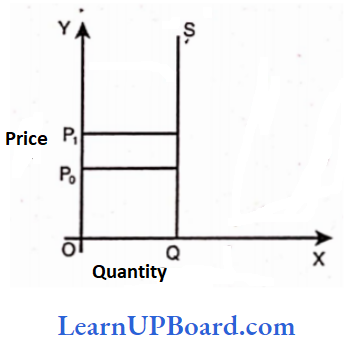
If due to a change in the price the quantity supplied of goods remains unchanged such goods are said to have inelastic supply i.e. their supply cannot be changed. This is shown by the vertical supply curve i.e. curve parallel to Y-axis.
Question 35. In the case of ___________________ there is an inverse relationship between income and demand for a product.
- Substitute goods
- Complementary goods
- Giffen Goods
- None of the above
Answer: 3. Giffen Goods
Giffen goods are the products for which demand increases as the price increases and falls when the price decreases. This is a special case of inferior goods which people buy less when thei income rises. Hence an inverse relationship is established between income and demand of the product.
Question 36. If maize has – 0.30 as income elasticity of demand then maize will be considered as.
- Necessity
- Inferior good.
- Superior good
- None
Answer: 2. Inferior good.
Since the income elasticity of maize is .30 < 0 it is an inferior commodity in the eyes of the household. The demand for inferior goods falls as income rises. Also as the elasticity is less than one it shows that the goods are either relatively less important in the consumer’s eye or it is a necessity.
Question 37. If the price decreases from ₹80 to ₹ 60 and the elasticity of demand is 1.25 then
- Demand increased by 25%
- Demand decreased by 25%
- Remains constant
- None of the above
Answer: 4. None of the above
Price Elasticity = Percentage change in quantity demanded
Percentage change in price
Given ⇒ Elasticity = 1.25 % change in price = \(\frac{60-80}{80}\) 25%
1.25 % = Change in Quantity / 25%.
Increase in Demand = -31.25%
Question 38. Which of the following are the conditions of the theory of consumer surplus if the price is the same for all the units he purchased?
- The consumer gains extra utility or surplus
- The consumer surplus for the last commodity is zero.
- Both
- None
Answer: 3. Both
The concept of consumer surplus is based on the law of diminishing marginal utility. If a consumer gets extra of something its marginal unity
starts decreasing.
Keeping the price the same for all the commodities a consumer gets extra utility for the units consumed by him except the one at the margin i.e. the last unit. The extra utility obtained
by the consumer is known as consumer surplus.
Question 39. Which of the following is not the property of an indifference curve?
- Slopes downwards to the right
- Always convex to the origin
- Intersects each other
- Will not touch either of the axes
Answer: 3. Intersects each other
The following are the properties of indifference curves:
- It slopes downwards to the right
- It is convex to the origin
- Two ICs never intersect each other-
- Higher IC represents a higher level of satisfaction.
- IC never touches either ax
Thus option (3) is not the property of an indifference curve.
Question 40. Which of the following is correct?
- Elasticity on the lower segment of the demand curve is greater than the unity
- Elasticity on the upper segment of the demand curve is lesser than unity
- Elasticity at the middle of the demand curve is equal to unity
- Elasticity decreases as one moves from the lower part of the
- Demand curve to the upper part
Answer: 3. Elasticity decreases as one moves from the lower part of the
Point elasticity at any point can be measured by the following formula
RT/ RT= Lower segment / Upper segment
- Elasticity on the lower segment of the demand curve is less than 1
- Elasticity at the middle of the demand curve is equal to unity
- Elasticity on the upper segment of the demand curve is more than 1
- Elasticity increases on one moves from the lower part of the demand curve to upper part.
Question 41. Which of the following will affect the demand for non-durable goods?
- Disposable Income
- Price.
- Demography
- All of the above
Answer: 4. All of the above
Factors affecting the demand for non-durable consumer goods are
- Disposable income
- Price
- Demography
Question 42. When the price of tea decreases people reduce the consumption of coffee. Then the goods are
- Complementaries
- Substitutes
- Inferior goods
- Normal goods
Answer: 2. Substitutes
Substitute goods are those goods that can be interchangeably used. Example tea and coffee ink pen and ball pen. If the price of a product falls people will try it and thus the demand for the other product will fall.
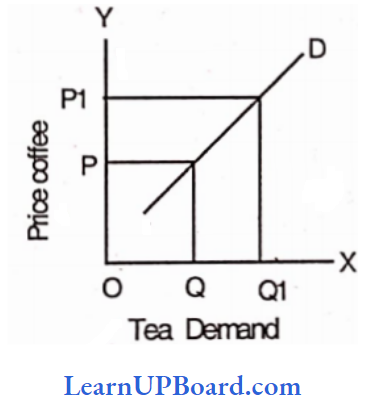
Question 43. Which of the following relations is true with MU?
- When MU is positive Total utility rises at a diminishing rate
- When marginal utility is zero total utility is maximum
- When marginal utility is negative total utility is diminishing
- All of the above
Answer: 4. All of the above
The relationship between marginal utility (MU) and Total Utility (TU) is as follows:
- When MU decreases TU increases at a decreasing rate
- When MU is zero TU is maximum
- When MU becomes negative TU declines.
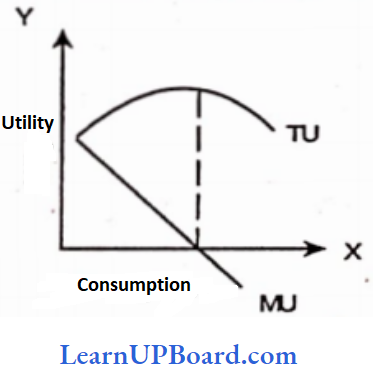
Question 44. The price elasticity of demand at the midpoint of the straight-line demand curve under the point method is
- 0
- 1
- >1
- <1
Answer: 2. 1
Given a straight line demand curve point elasticity can be calculated through.
RT / Rt = Lower segment / Upper segment

Thus, the price elasticity of demand at the midpoint under point method 1
Question 45. Contraction of supply implies.
- Decreased cost of production
- Decrease in price of the good concerned
- Decrease in price of related good
- Increase in price of the good concerned
Answer: 2. Decrease in price of the good concerned
Contraction in supply is the result of a decrease in price of the goods concerned.
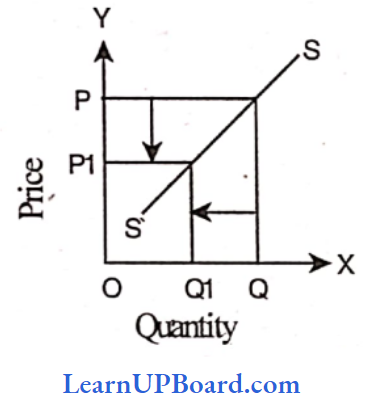
Question 46. Perishable commodities will have.
- Perfectly elastic curve
- Perfectly inelastic curve
- Elastic
- Inelastic
Answer: 2. Perfectly inelastic curve
The supply curve of perishables goods is perfectly inelastic. Perishable goods cannot be stored for a long time if stored the same will be
wasted thus its supply is limited and cannot be changed in the short run.
Question 47. Supply is a_______________ concept.
- Flow
- Stock
- Both (1) and (2)
- None of the above
Answer: 1. Flow
Supply refers to what a firm offers for sale in the market not necessarily to what they succeed in selling. What is offered may not get sold.
Supply is a flow concept. The quantity supplied is ‘so much’ per unit of time per day per week or year.
Question 48. Total utility is also known as
- Total satiety.
- Aggregate satiety.
- Full satiety
- Half satiety.
Answer: 1. Total satiety.
Total utility is measurable and additive total utility may be defined as the sum of utility derived from different units of a commodity consumed by a consumer.
Total utility is the sum of total marginal utilities derived from the consumption of different units i.e.
TU = MU1 + MU2 + …………………… + MUn
∴We can say that total utility is also known as total satiety.
Question 49. A vertical supply curve parallel to the axis implies the elasticity of supply is
- Zero
- Infinity.
- Equal to one
- Greater than zero but less than infinity
Answer: 1. Zero
A Vertical supply curve parallel to the y-axis implies that the elasticity of supply is Zero.
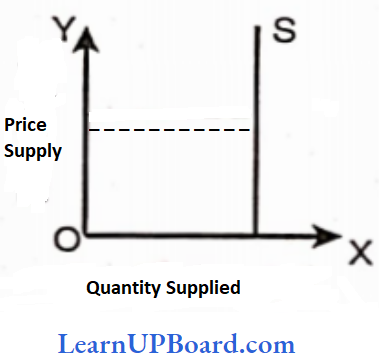
Question 50. The budget line is also called
- Price line
- Iso cost line
- Iso-quant
- None
Answer: 1. Price line
The budget line shows all those combinations of two goods which the consumer can buy spending his given money incomes on the two goods at their given prices. All those combinations are within the reach of the consumer. Will lie on the budget line.
∴ Px Oy + Py Qy≤ B
The budget line is also called the price line.
∴ Px Qx ⇒ Price and Quantity of good
Py Qy ⇒ Price and Quantity of good Y
B is the Budget
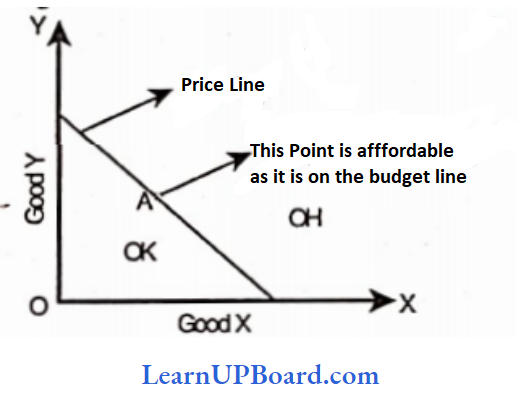
Question 51. The Quantity supplied of goods or services is the amount that
- As bought during a given period at a given price.
- Producers wish they could sell at a higher price
- Producers plan to sell during a given period at a given price.
- People are willing to buy during a green period at a given price.
Answer: 3. Producers plan to sell during a given period at a given price.
The quantity supplied of a good or service is the amount that producers plan to sell during a given period at a given price. The quantity supplied of a good also depends upon the government’s industrial and foreign policies goals of the firm infrastructural facilities etc.
The law of supply states that other things remaining constant the quantity of a good produced and offered for sale will increase as the price of the good rises and decreases as the price falls.

Question 52. Luxury goods have an income elasticity
- Negative and less than 1
- Positive and greater than 1
- Zero
- None
Answer: 2. Positive and greater than 1
Luxury goods have income elasticity is positive and greater than one
Demand for luxury goods arises beyond a certain level of consumers’ income and keeps on rising as income increases
Example: Car, TV etc
Elasticity is greater than one when the percentage change in quantity demanded is greater than the percentage change in price.
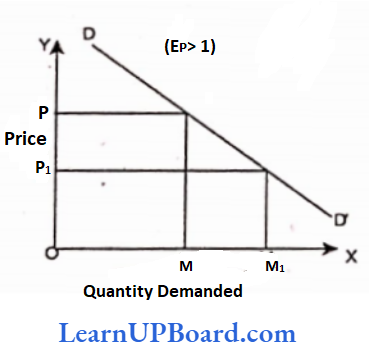
Question 53. Percentage change quantity supplied is divided by to obtain elasticity of supply
- Percentage decrease in price
- Percentage change in price
- Both (1) and (2)
- None
Answer: 2. Percentage change in price
Percentage change in quantity supplied is divided by percentage change in price to obtain elasticity of supply.
Es= Percentage change in Quantity Supplied / Percentage change in Price
Question 54. If the price of the product is? 20 per unit and if the price decreases by 5% as a result of which quantity demanded increases by 10% find MR- old quantity is 10 units.
- 9
- 19
- 10
- 12
Answer: 1. 9
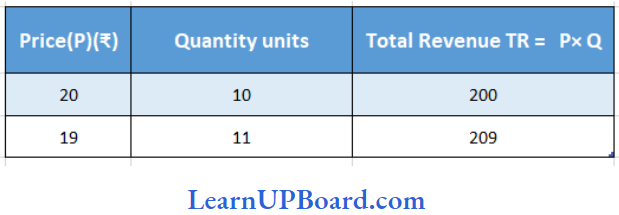
If the price of the product is? 20 per unit and if the price decreases by 5% as a result of which quantity demanded increases by 10%
MRn= TRn -TRn-1
MR11= TR1 -TR11-1
MR11=209-200
MR11= 9
Question 55. Law of demand relates to:
- Price only
- Price and quantity demanded of a good
- Quantity demanded only
- Supply
Answer: 2. Price and quantity demanded of a good
The law of demand relates to the price and quantity demanded of a good. As Prof. Alfred Marshall” defined the Law of Demand as – The greater the amount to be sold the smaller the price at which it is offered so that it may find purchasers or in other words, the amount demanded increases with a fall In price and diminishes with a price rise.
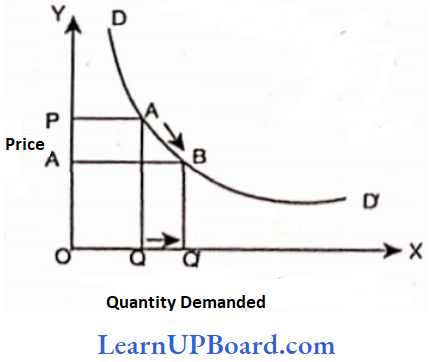
Question 56. An indifference curve slopes down towards the right since more of one commodity and of another commodity results in
- The same level of satisfaction
- Maximum satisfaction
- Greater satisfaction
- Less satisfaction
Answer: 1. Same level of satisfaction
The indifference curve slopes down towards the right since more of one commodity and of another commodity result in the same level of – satisfaction. The downward slope of the indifference curve states that two commodities can be substituted for each other and when the amount of one good in the combination is increased the amount of the other good is reduced. This is essential if the level of satisfaction is to remain the same on an indifference curve.
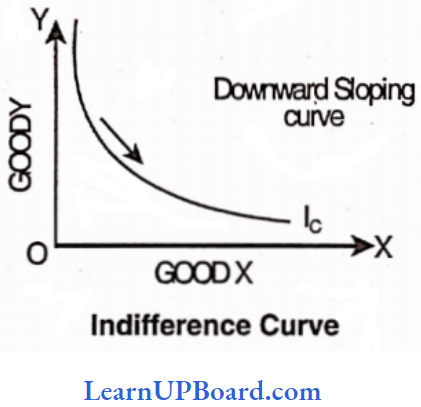
Question 57. Elasticity for habitual goods is.
- Perfectly elastic
- Elastic
- Perfectly inelastic
- Inelastic
Answer: 4. Inelastic
Elasticity for habitual goods is inelastic. Elasticity is less than one when the percentage change in quantity demanded is less than the percentage change in price. In such cases, demand is said to be inelastic.
EP = Percentage Change Quantity Demanded / Percentage Change in Price
Question 58. Diminishing marginal returns for the first four units of variable inputs are exhibited by the total product sequences.
- 50, 100, 150, 200
- 50, 50, 50, 50
- 50, 110, 150, 260
- 50, 90, 120, 140
Answer: 4. 50, 90, 120, 140
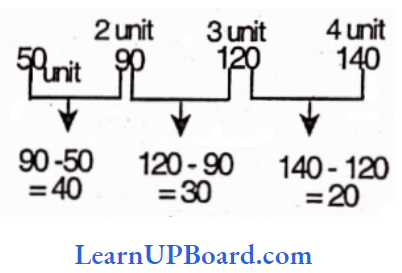
Question 59. Demand forecasting using asking customers what they are going to buy comes under:
- Survey of buyers’ intentions
- Statistical method
- Grassroots method
- Expert opinion method
Answer: 1. Survey of buyers’ intentions
Survey of buyers’ intention – a forecasting technique in which known purchasers of a product are asked to predict their requirements for a given future period.
Question 60. When the price of petrol decreases people reduce the consumption of diesel then the goods are:
- Mixed
- Complementary
- Superior
- Substitutes
Answer: 4. Substitutes
Substitute goods are two alternative goods that could be used for some purpose. When the price of petrol decreases people reduce the
consumption of diesel.
Question 61. The price of an apple is ₹ 120 per kg. Ram buys one kg. of apples at that price. Now if other things remain the same but the price of apples falls to? 90 per kg. Now Ram buys 2 kg of apples. It is called as:
- Contraction of demand
- Expansion of demand
- Market demand
- Demand schedule
Answer: 2. Expansion of demand
The price of an apple is ₹ 120 per kg. Ram buys one kg. of apples at that price. Now if other things remain the same but the price of apples falls to? 90 per kg. Now Ram buys 2 kg of apples
Expansion in demand refers to a rise in the quantity demanded due to a fall in the price of a commodity other factors remaining constant leads to a downward movement along the demand curve.
Question 62. To know the base price and quantity which method of elasticity is used?
- Arc Elasticity.
- Cross Elasticity
- Point Elasticity
- Zero Elasticity
Answer: 1. Arc Elasticity.
In Arc elasticity it can be calculated by using the formula:
Ep = (q1– q2)/(q1+ q2)× (p1+p2)/(p1 – p2)
This is because elasticities found by using original price and quantity figures as a base will be different from the ones derived by using new price and quantity figures.
Question 63. The price elasticity of demand for X is 1 and the average quantity demand of X is 90 units. If the price of X decreases from ₹ 300 to ₹ 180 per unit calculate the new quantity demand of X is:
- 126 units
- 36 units
- 144 units
- 120 units
Answer: 1. 126 units
The price elasticity of demand for X is 1 and the average quantity demand of X is 90 units. If the price of X decreases from ₹ 300 to ₹ 180 per unit
It can be calculated by using the formula:
e = (Q1– Q0)/(Q0) × (P0)/(P1– P0)
⇒ 1 = (Q1– 90)/(90) × (300)/(300-180)
Q1 = 126 units
Question 64. If the quantity supply changes substantially in response to small changes in the price of the good then it is:
- Relatively greater elastic supply
- Relatively less elastic supply
- Unitary elastic
- Perfect elastic
Answer: 1. Relatively greater elastic supply
If the elasticity of supply is greater than one i.e. when the quantity supplied of good changes substantially in response to a small change in the price of the good we say that supply is relatively elastic.
Question 65. If the Indifference curve is L shaped means two goods will be:
- Perfect complementary goods
- Perfect substitute goods
- Perfect inferior goods
- Perfect superior goods
Answer: 1. Perfect complementary goods
When two goods are perfect complements they are represented by a ‘L’ shaped indifference curve.
Question 66. Let us assume that in the OY axis, we have good A and on the OX axis good B. If the price of good B increases by ? 1 but the price of good A remains constant and income also remains unchanged the budget line will shift:
- Right on the OY axis
- Right on the OX axis
- Left on the OY axis
- Left on the OX axis.
Answer: 4. Left on the OX axis.
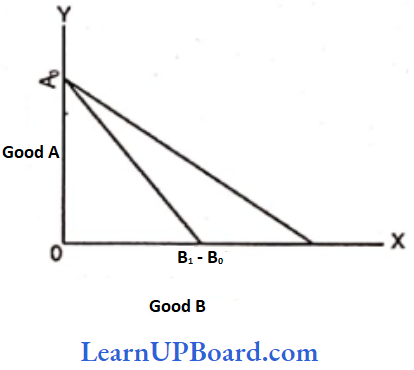
Left on ox axis
In this diagram, we can see that good B has shifted leftward towards the ox-axis.
Question 67. Purushotham wanted to buy a laptop by paying. 60000 but the actual price is? 55000 then the consumer surplus is:
- ₹ 60000
- ₹ 55000
- ₹5000
- ₹ 6500
Answer: 3. ₹5000
Consumer’s surplus = What a consumer is ready to pay – What he pays
∴ Consumer’s Surplus = 60000 – 55000
= ₹ 5000.
Question 68. Effective demand depends on.
- Price
- Cost
- Desire
- Product
Answer: 1. Price
Effective demand depends upon various factors but according to the given question, it mainly depends upon price.
Question 69. Why does the demand curve slope downwards?
- Law of diminishing marginal cost
- Arrival of old consumers
- Cost effect.
- Different users
Answer: 2. Arrival of old consumers
Generally demand curve slopes downward from left to right. It is due to many reasons such as the law of diminishing marginal utility price effect substitution affects the arrival of old consumers and many uses of a commodity.
Question 70. What is not a determinant of demand?
- Consumer’s expectations
- Consumer’s tastes and preferences
- Income of the consumers.
- Prices of unrelated goods.
Answer: 4. Prices of unrelated goods.
Demand depends upon various determinants such as price income taste and preference price of related commodities climatic factors etc.
Question 71. What are the exceptions to the Law of Demand
- Law of Diminishing Marginal Utility
- Substitution effect
- Conspicuous goods
- Different uses.
Answer: 3. Conspicuous goods
Generally law of demand slopes downward but sometimes it slopes upward which is known as an exception to the law of demand. The various reasons are Giffen goods conspicuous goods during. emergencies etc.
Question 72. Identify the factor which generally keeps the price elasticity of a good. law:
- Variety of uses for that good
- Very low price of a commodity
- Close substitutes for that good
- A high proportion of the consumer’s income is spent on it. (Tmark) Answer:
Answer: 2. Very low price of a commodity
Question 73. In the case of inferior goods, the income elasticity of demand is
- Positive
- Zero
- Negative
- Infinite
Answer: 3. Negative
In the case of inferior goods, the income elasticity of demand is Negative which means that due to the increase in income, the quantity consumed (inferior goods) decreases The price elasticity of a good is low if the price of a commodity is very low. low i.e. it is inelastic.
Question 74. What is a numerical measure of elasticity for Perfectly Elastic”
- Zero
- Infinity
- Greater than one and less than infinity.
- Less than one
Answer: 2. Infinity
The numerical value of elasticity of perfect elastic = (∞)
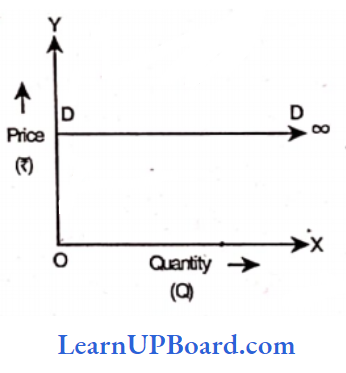
Question 75. The price of 1 kg. of tea is ₹ 30 demand at this price is 5 kg. If the price of coffee rises from 25 to 35 per kg. the quantity demanded of tea rises from 5kg. to 8 kg. Find out the cross elasticity of tea.
- -1.5
- 1.5
- 3
- 1
Answer: 2. 1.5
The price of 1 kg. of tea is ₹ 30 demand at this price is 5 kg. If the price of coffee rises from 25 to 35 per kg. the quantity demanded of tea rises from 5kg. to 8 kg.
Cross Elasticity = Δ qx/Δ py × py/qx
Where x = Tea , y = Coffee
= \(\frac{5-8}{-10}\)× \(\frac{25}{5}\)
= \(\frac{+3}{+10}\)× \(\frac{25}{5}\)
= +1.5
Question 76. Supply is a concept.
- Flow.
- Stock
- Flow and Stock
- None of the above.
Answer: 1. Flow
Supply is a flow concept. The quantity supplied is so much per unit of time per day per week or per year.
Question 77. When supply curves move to the right it means:
- Supply increases
- Supply decreases
- Supply remains constant.
- Supply expands
Answer: .1. Supply Increases.
When supply curves move to the right it means an increase in supply.
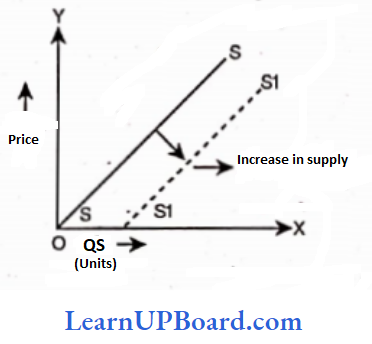
Question 78. The second glass of lemonade gives lesser satisfaction to a thirsty boy. This is a clear case of:
- Law of demand
- Law of diminishing returns
- Law of diminishing marginal utility
- Law of supply.
Answer: 3. Law of diminishing marginal utility
The second glass of lemonade gives lesser satisfaction to a thirsty boy. This is a clear case of diminishing marginal utility.
Question 79. The quantity demanded of coffee increases by 2% when the price of tea – increases by 8% the cross elasticity of demand between two product
are:
- -0.30
- + 0.30
- +0.25
- – 0.25
Answer: 3. +0.25
Cross elasticity = Percentage change in quantity demanded/ Percentage change in Price
⇒ \(\frac{2}{8}\) %
= 0.25
Question 80. Goods which are inferior with no close substitutes easily available and which occupy a substantial place in consumer’s budget are called goods.
- Giffen
- Conspicuous
- Speculative.
- Prestige.
Answer: 1. Giffen
Such goods that exhibit a direct price-demand relationship are called Giffen goods. Giffen goods are those inferior goods whose demand increases as their price increases. Those goods that are inferior with no close substitutes easily available and which occupy a substantial place in consumers’ budgets.
Question 81. Suppose the demand for automobiles decreases due to an increase in the price of petrol both the goods are:
- Normal
- Substitute
- Perishable
- Complementary
Answer: 4. Complementary
Complementary goods are those goods which are consumed together or simultaneously for example automobile and Petrol. When two commodities are
complements a fall in the price of one will cause the demand for the other to rise.
Question 82. Marshall defined the concept of consumer surplus as the.
- The area covered in between the average revenue and marginal revenue curve
- Difference between the maximum amount a person is willing to pay far goods and the amount he pays
- The area inside the budget line
- Difference between the minimum amount a person is willing to pay for a good and its market price
Answer: 2. Area covered in between the average revenue and marginal revenue curve
Marshall defined the concept of consumer Surplus as the difference between what a consumer is ready to pay and what he actually pays.
Question 83. Of the following who developed the Delphi technique of Demand forecasting?
- Olaf Helmer.
- David Richardson
- Michael Porter
- J.M. Keynes
Answer: 1. Olaf Helmer.
The Delphi technique developed by Olaf Helmer at the Rand Corporation of the USA provides a useful way to obtain an informed judgment from diverse experts by avoiding disadvantages. conventional panel meeting. .
Question 84. Indifference curve analysis is based on which approach?
- Nominal.
- Cardinal.
- Marginal
- Ordinal
Answer: 4. Marginal
Indifference curve analysis is based on the ordinal approach. The indifference curve analysis assumes that utility is only ordinally expressible. The consumer is capable of ranking all conceivable combinations of goods according to satisfaction.
Question 85. Read the following table and answer questions no
Answer:
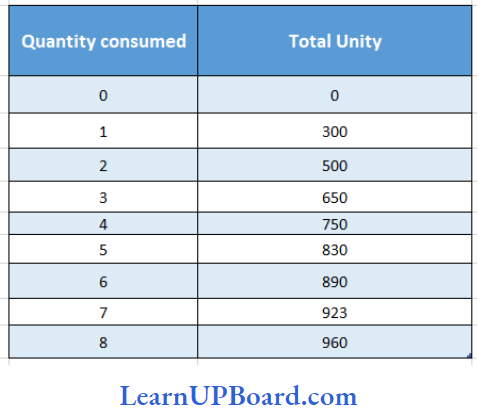
What is marginal utility consumption increases from 4 units to units:
- 130
- 80
- 160
- 100
Answer: 2. 80
Marginal utility =Tun-Tun-1
= Tu5 – Tu4
= 830 – 750
= ₹ 80
Question 86. What is Marginal utility when consumption increases from 7 units to 8 units?
- 60.
- 100
- 40
- 30.
Answer: 4. 30
Marginal utility = Tun-Tun-1
= Tu8 – Tu(8-1)
= Tu8 – Tu(7)
= 960 – 930
= ₹ 30
Question 87. The price of a commodity decreases from? 200 to? 120 per unit. If the price elasticity of Demand for this commodity is 2 and the original. quantity demanded is 60 units calculate the new quantity demanded.
- 48 units
- 100 units
- 120 units
- 108 units.
Answer: 4.
The price of a commodity decreases from? 200 to? 120 per unit. If the price elasticity of Demand for this commodity is 2 and the original.
Original quantity demanded = 60 units
Elasticity = 2 times.
Original price = ₹ 200
New prices =₹ 120.
Price elasticity = ΔQ/Δ P × P/Q
2 = ΔQ/80 × 200/60
ΔQ = 48
New quantity = original quantity + A Q = 60 units + 48 units
= 108 units.
Question 88. A group of people decreases or altogether stops consumption of a common product due to which of the following effect?
- Veblen effect
- Demonstration effect.
- Bandwagon effect
- Snob effect.
Answer: 4. Snob effect.
When a product becomes common among all some people decrease or altogether stop its consumption this is called the snob effect. .
Question 89. Highly-priced goods are consumed by status-seeking rich people to satisfy their need for conspicuous consumption. This is called:
- Veblen effect
- Demonstration effect
- Snob effect
- Bandwagon effect
Answer: 1. Veblen effect
Veblen effect was given by Veblen. Hence it is called the Veblen effect also known as the prestige goods effect. The Veblen effect takes place as some consumers measure the utility by its price i.e. if the price rises. them they think that commodities have got more utility. The Veblen effect is the behavior
practiced by rich people to satisfy their need for conspicuous goods.
Question 90. Which of the following product elasticity of demand is highly elastic?
- Salt
- Jewellery
- Life-saving medicines
- Water.
Answer: 2. Jewellery
Jewellery has the elasticity of demand is highly elastic because due to an increase in the price of jewelry, more will be demand on the other hand
necessaries goods like salt water medicines are elastic.
Question 91. The indifferences curve for two perfect complementary goods is
- Z shaped
- L shaped
- U shaped
- .Straight line
Answer: 2. L shaped
When two goods are perfect complementary goods (e.g pointer and cartridge) the indifference curve will consist of two straight lines with a right angle bent which is convex to the origin or in other words it will be L-shaped.
Question 92. Assume that wheat has (-) 0.4 as income elasticity by this we can say:
- Wheat is normal and good.
- Wheat is an inferior good
- Wheat is a superior good
- Wheat is a luxurious good
Answer: 2. Wheat is an inferior good
Since the income elasticity of wheat is – 0.4 < 0 it is an inferior good. The demand for inferior goods falls as income rises. Also, the elasticity is less than one it shows the goods is either relatively less important in the consumer’s eye or it is a necessity.
Question 93. The equation of supply is given as Q = 20p – 200. If the price is? 30 then find the elasticity.
- +1.5
- – 0.5.
- 0.66
- -0.66
Answer: 1. +1.5
The elasticity of demand measures how the quantity demanded of a commodity will change in response to the changes in its price. The elasticity of a good depends on the factors like nature of the good availability of substitutes income level share in the expenditure etc.
Hence
Es = dq/dp ×p/q
Since dq/dp = 20
P = 30
q = 20 × 30 – 200
q = 400
∴ Es = \(\frac{20×30}{400}\)
= 1.5
Question 94. Who coined the term ‘Demonstration effect’?
- Adam Smith
- Veblen
- James Duesenbury.
- Alfred Marshall
Answer: 3. James Duesenbury.
James Duesenberry (1949) gave the name”demonstration effect” to this phenomenon arguing that it promoted unhappiness with current levels of consumption which impacted savings rates and consequently opportunities for macroeconomic growth.
Question 95.MRS from X to Y can be defined as
- Change in Y to change in X
- Px/Py
- py/px
- Change in X to change in Y
Answer: 2. Px/Py
MRS is calculated between two goods placed on an indifference curve displaying a frontier of utility for each combination of “good X” and “good Y.” The slope of this curve represents quantities of good X and good Y that you would be happy substituting for one another.
Question 96. In the case of goods, the demand will rise to the fall of price only if the substitution effect outweighs the income effect.
- Inferior goods
- Necessaries
- Giffen goods
- Luxury goods.
Answer: 1. Inferior goods
The increase in demand on account of an increase in real income is known as income effect. When the price of a commodity falls the consumer can buy the same quantity of the commodity with less money or he can buy more of the same commodity with the same amount of money.
- In other words as a result of a fall in the price of the commodity consumer’s real income or purchasing power increases.
- A part or whole of the resulting increase in real income can now be used to buy more of the commodity in question given that the good is normal.
- Therefore the demand for that commodity (whose price has fallen) increases.
- However, there is one exception. In the case of inferior goods, the income effect works in the opposite direction to the substitution effect.
- In the case of inferior goods, the expansion in demand due to a price fall will take place only if the substitution effect outweighs the income effect.
Question 97. The value of demand elasticity can be taken from
- – 1 to + 1
- – 1 to ∞
- 0 to ∞
- – 1 to 0
Answer: 1. – 1 to + 1
The elasticity of demand for a given good or service is calculated by dividing the percentage change in quantity demanded by the percentage change in price. If the elasticity quotient is greater than or equal to one the demand is considered to be elastic.
Question 98. Consumer surplus is derived from which concept?
- Law of Diminishing Marginal Utility
- Law of consumer surplus
- Law of indifference curve.
- Maximization of Profits
Answer: 1. Law of Diminishing Marginal Utility
Consumer surplus is derived from the law of Diminishing Marginal utility. Consumer surplus is based on the economic theory of marginal utility which is the additional satisfaction a consumer gains from- one more unit of a good or service. Consumer surplus always increases as the price of a good falls and decreases as the price of a good rises.
Question 99. The law of Diminishing Marginal Utility is derived from.
- Indifference curve
- Consumer surplus
- Maximization of profits ‘
- Expansion of firm
Answer: 2. Consumer surplus
The law of diminishing marginal utility states that all else equal as – consumption increases the marginal utility derived from each additional unit declines. Marginal utility is the incremental increase in utility that results from the consumption of one additional unit i.e. consumer surplus.
Question 100. Hicks and Allen believed that utility
- Can be measured in ordinal numbers.
- Can be measured in cardinal numbers
- Can be measured
- Cannot be measured
Answer: 1. Can be measured in ordinal numbers.
Hicks and Allen believed that utility can be measured in ordinal numbers. The ordinal analysis of demand is based on the indifference curve which represents the consumer’s preferences graphically. An indifference curve is a curve that represents all those combinations of two goods that give the same satisfaction to the consumer.
Question 101. At the point of satiation, TU is and MU is.
- Maximum zero
- Minimum Minimum
- Zero Maximum
- Maximum Maximum.
Answer: 1. Maximum zero
When Marginal Utility is Zero Total Utility is the maximum and it is the point of maximum satisfaction i.e. point of satiety.
Question 102. Demand refers to
- Need for a commodity
- Use for a commodity *
- Unlimited wants
- It is a desire backed by purchasing power ability and willingness to pay.
Answer: 4. It is a desire backed by purchasing power ability and willingness to pay.
The effective demand for a thing depends on:
- Desire
- Means purchasing and
- Willingness to use.
Those means for that purchase. Unless desire is backed by purchasing power or ability to pay and willingness to pay it does not constitute demand. Effective demand alone would figure in economic analysis and business decisions.
Question 103. Budget Line will be affected by
- Change in demand
- Change-in income
- Change in supply
- Change in equilibrium
Answer: 2. Change-in income
The budget constraint can be explained by the budget line or price line. In simple words, a budget line shows all those combinations of two goods which the consumer can buy spending his given money income on the two goods at their given prices. All those combinations that are within the reach of the consumer (assuming that he spends all his money and income) will lie on the budget line.
Question 104. Utility can be measured in
- Units
- Utils
- Points
- Numbers
Answer: 2. Utils
According to the neoclassical economists utility is a cardinal concept i.e. utility is a measurable and quantifiable entity. It implies that utility can be measured in cardinal numbers and may be assigned a cardinal number like 12 3 etc.
Marshall and some other economists used a psychological unit of measurement of a utility called utils. According to Marshall utility is the numerical score in terms of ‘utils’ representing the satisfaction that a consumer obtains from the consumption of a particular good. (Utils refer to the hypothetical measuring unit of utility).
Question 105. Which of the following is the property of IC?
- IC is concave to the origin
- ICs intersect each other –
- IC slopes upward to the left
- IC does not touch either the x-axis or y-axis
Answer: 4. IC does not touch either the x-axis or y-axis
The four properties of indifference curves are:
1. Indifference curves can never cross
2. The farther out an indifference curve lies the higher the utility it indicates
3. Indifference curves always slope downwards and
4. Indifference curves are convex.
Question 106. The dealings of Aeroplanes as given below are__________
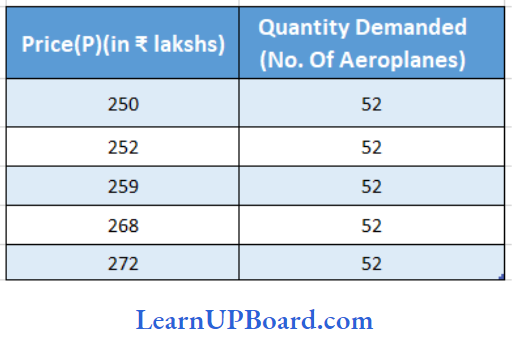
This represents________
- Perfectly inelastic demand
- Perfectly elastic demand
- Unit Elastic
- Relative inelastic.
Answer: 1. Perfectly inelastic demand
Question 107. During lockdown due to covid 19, a consumer finds that vegetable vendors selling vegetables in the streets have raised the prices of vegetables than usual prices. She will buy vegetables than as her usual demand showing the demand for vegetables is
- Same; Elastic demand
- Same; Inelastic demand .
- Less; Elastic demand
- More; Inelastic demand
Answer: 2. Same; Inelastic demand.
During lockdown due to covid 19, a consumer finds the vegetable vendors selling vegetables in the streets have raised the prices of vegetables than usual prices. She will buy the same vegetable/as her usual demand showing the demand for vegetables is Inelastic demand.
Question 108. For Giffen goods, the angle curve is:
- Vertical
- Horizontal
- Negatively slopped
- Positively slopped
Answer: 3. Negatively slopped
For Giffen goods, the angle curve is negatively slopped. A Giffen good is a low-income non-luxury product that defies standards. economic and consumer demand theory. Demand for Giffen goods rises when the price rises and falls when the price falls. In econometrics this results in an upward-sloping demand curve contrary to the fundamental laws of demand which create a downward-sloping demand curve.
Question 109. Elasticity is measured at a given point on the supply curve
- Point elasticity.
- Arc elasticity
- Cross elasticity
- None of the above.
Answer: 1. Point elasticity.
The point elasticity of demand is the price elasticity of demand at a particular point on the demand curve. The price change. elasticity when is infinitesimal (very negligible) we use point elasticity.
Question 110. Price change is larger than proportionate to change in demand which type of elasticity?
- Elastic
- Infinite
- Zero
- Inelastic
Answer: 4. Inelastic
Demand is inelastic. when price change is larger than proportionate the change in demand.
Elasticity < 1
Demand curve of elasticity less than one.
Question 111. Veblen effect slopes toward
- Downward to
- Upward
- Negative
- Positive
Answer: 2. Upward
The demand curve for a veblen good is upward sloping contrary to a normal demand curve which is downward sloping. When the price of a Veblen good goes up demand goes up.
Question 112. Advertising elasticity of demand is always
- Positive
- Negative
- Constant
- All of the above
Answer: 1. Positive
Advertisement elasticity of demand is most of the time positive. Advertisement elasticity is typically positive. Advertisement elasticity varies between zero and infinity.
Question 113. The graph of perfect complimentary goods is:
- Straight line
- L shaped
- U shaped.
- None of the above
Answer: 2. L shaped
When goods are perfect compliments consumers consume them in fixed proportions. The indifference curve will consist of straight lines with a right angle bent convex to the origin.
Hence if will be ‘L’ shaped.
Question 114. Which of the following is not an exception to the law of demand?
- Giffen goods
- Conspicuous goods
- White goods
- None of the above
Answer: 3. White goods
White goods are heavily priced slow-moving goods.
Examples: Computers, radios washing machines etc.
Every other good example giffen goods conspicuous goods and speculative goods are exceptions to lav/ of demand.
Question 115. When price increases fewer units are sold which tends to lower the revenue.
- Income effect
- Price effect
- Quantity effect
- Substitution effect
Answer: 3. Quantity effect
Quantity effect after a price increase fewer units are sold which tends to lower the revenue.
If the quantity effect which sends to reduces total revenue is the stronger total revenue is reduced.
Question 116. The price of sugar falls from? 10000 to 7 8000 & Quantity decrease from 2500 to 2000 find elasticity of supply
- 0
- 1
- -1
- 2
Answer: 2. 1
E(s)= ΔQ / Q × P/ ΔP
= \(\frac{2000}{10000}\) × \(\frac{2500}{500}\)
= 1
Question 117. The law of demand states that the quantity purchased.
- Varies Inversely with price.
- Varies directly proportional to the price
- Varies similar to the price
- None of the above
Answer: 1. Varies Inversely with price.
Varies inversely with the price
Reason: The law of demand states that the quantity purchased varies inversely with price. In other words the higher the price the lower the quantity demanded. This occurs because of diminishing marginal utility.
Question 118. If the quantity demanded of mutton increases by 5 % when the price of chicken increases by 25% the price elasticity of demand is –
- 0.2
- -1
- 0
- 0.8
Answer: 1. 0.2
Cross Price elasticity is → Demand of good X(%)/ Price of good Y(%)
= (\(\frac{5}{25}\))%
= 0.2
Question 119. A vertical supply. curve parallel to the axis implies that the elasticity of supply is
- Zero
- Infinity
- More than one 1
- Less than one
Answer: 1. Zero
A vertical supply curve parallel to the axis implies that the elasticity of supply is inelastic (highly) and is zero.
No change in demand when price changes
Question 120. If the customer is habitual then elasticity is
- Relative elastic
- Negative
- Zero
- Inelastic
Answer: 4. Inelastic
If a customer has habitual use of a commodity no matter how much its price changes the demand for the commodity will be inelastic. If buyers have preference demand will be inelastic.
Question 121. Consumer surplus is what he is willing to pay less
- What he pays
- The price of the goods
- Money spent on goods
- All of the above
Answer: 1. What he pays
Consumer Surplus:
= What the consumer is willing to pay – What he pays.
Question 122. If advertisement is increased by 25% & demand is only increased by 5%. Find advertisement elasticity.
- -1
- 1
- 0.2
- -0.2
Answer: 3. 0.2
Advertisement elasticity ⇒ Increase in demand/Advertisement Exp
⇒ (\(\frac{5}{25}\))%
= 0.02
Question 123. When demand decreases due to price increase it is?
- Change in demand
- Increase in demand
- Contraction in demand
- Decrease in demand
Answer: 3. Contraction in demand
When demand decreases due to a price increase it is a contraction of demand.
Question 124. If an indifference curve is L-shaped then two goods will be.
- Perfect substitute goods.
- Substitute goods
- Perfect complementary goods
- Complementary goods
Answer: 3. Perfect complementary goods
When two goods are perfect complimentary goods indifference curve will be L-shaped.
Question 125. When the elasticity of supply is infinite, the curve will be:
- Parallel to X-axis
- Parallel to Y-axis
- Upward sloping
- Downward sloping
Answer: 1. Parallel to X-axis
When the elasticity of supply is:
- Perfectly elastic (Es = ∞); Curve is parallel to x-axis
- Perfectly inelastic (Es = 0): The curve is parallel to the y-axis
- Unit elastic (Es = 1): Curve is upward sloping and cuts the –
origin - Less elastic (0 < Es < 1): The curve is more slopier and cuts the x-axis
- Greaver elastic (1 < (Es <∞ ): Curve is more flatter and cuts y-axis
Question 126. Ram and Sons are going for a heavy advertisement campaign to enhance their sales. When analyzed it was realized that the expenditure on advertisement by the company has gone up from ₹ 2,00,000 to 3,00,000 and the sales of this product increased from 10 lakh units to 20 lakh units. What is the advertising elasticity of demand?
- -1
- 4
- 2
- 3
Answer: 3. 2
Ram and Sons are going for a heavy advertisement campaign to enhance their sales. When analyzed it was realized that the expenditure on advertisement by the company has gone up from ₹ 2,00,000 to 3,00,000 and the sales of this product increased from 10 lakh units to 20 lakh units.
Advertisement elasticity =
Question 127. If the quantity demanded of mutton increases by 5% when the price of chicken increases by 20%, the cross-price elasticity of demand between mutton and chicken is:
- 0.25
- -4
- 4
- -0.25
Answer: 1. 0.25
Ed =% Change in quality demanded / % Change in price
= Δ Qd/Q × p/Δ p
= (\(\frac{5}{20}\)) %
= 0.25
Question 128. The household income rises by 20% in a year consequently the demand of TV sets rises by 30% what is the income elasticity of demand?
- 1.5
- 0.5
- 0.4
- 5
Answer:1. 1.5
Income elasticity = % Change in quality demanded / % Change in price
= \(\frac{30}{20}\)
= 1.5
Question 129. Which of the following methods calculates the elasticity of demand by using a formula?
Lower segment of demand Curve / Upper segment of demand curve
- They are the elasticity method
- Cross elasticity method
- The income elasticity method
- The point elasticity method
Answer: 4. The point elasticity method
Point elasticity of demand = Lower segment of demand Curve / Upper segment of demand curve
Question 130. When marginal utility is zero then total utility is
- Maximum
- Lower
- Negative
- Increasing
Answer: 1. Maximum
Relationship between TU and MU:
- TU rises as long as MU is positive, but at a diminishing rate because MU is diminishing
- MU diminishes throughout
- When MU = O, TU is maximum it is the satiation point
- When MU is negative, TU is diminishing
- MU is the rate of change of total utility or it is the slope of TU
curve - MU can be positive, zero, or negative
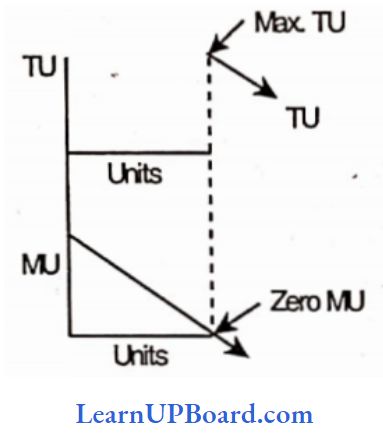
Question 131. The extent to which the demand for a consumer’s good is decreased because others are also consuming the same commodity ‘ refers to:
- Bandwagon effect
- Snob effect
- Veblen effect
- None of the above
Answer: 2. Snob effect
By Snob effect, we refer to two extent to which the demand for a consumer’s good is decreased because others are also consuming the same commodity.,
Question 132. Suppose the income elasticity of air conditioners is +1.8, which kind of good is an air conditioner?
- Conspicuous goods
- Normal good
- Inferior good
- Superior good
Answer: 2. Normal good
Income elasticity will be positive in the case of normal goods. As Air conditioners are a luxury good and there is no precise definition of ‘ a luxury, but one might expect the income elasticity to be greater than +1.
Question 133. Change in demand due to an increase in the real income of a consumer is called
- Income effect
- Substitution effect
- Marginal effect
- Price effect
Answer: 1. Income effect
The increase in demand on account of an increase in real income is known
as income effect.
Question 134. If the price of good X increases, demand for good Y also increases, the two goods are:
- Substitutes
- Complementary goods
- Normal goods
- Giffen goods
Answer: 1. Substitutes
Substitute goods are those goods that can be interchangeably used. For example, tea and coffee, ink pen and ball pen. If the price of a product falls the people will try it and thus, the demand for the other product will fall.
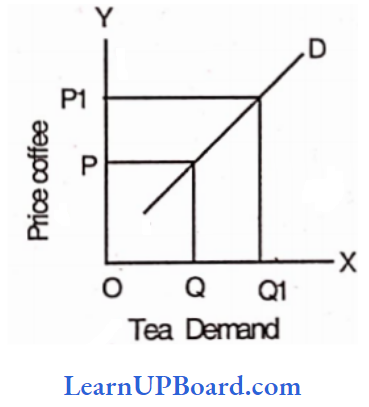
Question 135. The Delphi technique of demand forecasting is also called
- Expert opinion method
- Collective opinion method
- Controlled experiments
- Barometric method
Answer: 1. Expert opinion method
The Delphi technique which is also known as the Expert Opinion method is developed by Olaf Helmer at the Rand Corporation of the USA and provides a useful way to obtain informed judgments from diverse experts by avoiding the disadvantages. conventional panel meeting.
Under his method, instead of depending upon the opinions of buyers and. salesmen, the firm solicits. the opinion of specialists or experts through a series of carefully designed questionnaires. Experts are asked to provide forecasts and reasons for their forecasts
Question 136. Which of the following is not a statistical method of forecasting?
- Survey of buyers’ intentions
- Regression Analysis
- Freehand projection method
- Least square method
Answer: 1. Survey of buyers’ intentions
Statistical methods have proved to be very useful in forecasting demand. Forecasting using statistical methods is considered – superior methods because they are more scientific, reliable, and free from subjectivity.
Import statistical methods of forecasting are:
- Trend projection method, which is also known as a classical method, its popular techniques are
- Graphical Method, is also known as Freehand.
- The fitting trend equation is also known as the Least Square Method.
- Regression Analysis is the most popular method of forecasting.
Question 137. An indifference curve represents the combination of two commodities which give the consumer:
- Equal satisfaction.
- Greater satisfaction
- Less satisfaction.
- No satisfaction
Answer: 1. Equal satisfaction
An indifference curve of two commodities represents that combination which gives consumers Equal Satisfaction.
Question 138. “Which of the following is NOT meant by liberalization?
- Decontrol
- Disinvestment of PSU’s
- Freedom to do business
- Deregulation
Answer: 3. Freedom to do business
In an economy, liberalization aims to run a business without any barriers like without having any control, without any regulations. There is no hindrance to doing any business.
Question 139. Which of the following is not an assumption of marginal utility analysis?
- Consumer rationality
- Cardinal measurability of utility
- Ordinal measurability of utility
- Continuity in consumption
Answer: 3. Ordinal measurability of utility
Ordinal measurability of utility means that utility can be ranked, which can be possible only in indifference curve analysis and not marginal utility analysis.
Question 140. If the demand of Bajra decreases due to a decrease in its price, then Bajra is a
- Superior Good
- Inferior Good
- Necessity Good
- Luxury Good
Answer: 2. Inferior Good
If the price of Bajra decreases, there will be an increase in the real income of consumers which will lead to a decrease in demand for Bajra. Hence, it is an inferior good.
Question 141. There is a decrease in the price of LED TVs after the budget announcement from ₹ 60,000 to ₹ 50,000. As a result to demand for it has increased from 1500 units to 2000 units. The elasticity of demand for LED TV will be:
- 1.27
- 1.57
- 0.63
- 0.67
Answer: 2. 1.57
There is a decrease in the price of LED TVs after the budget announcement from ₹ 60,000 to ₹ 50,000. As a result to demand for it has increased from 1500 units to 2000 units.
P0= ₹ 60,000, P1 = ₹ 50,000,
∴ ΔP = 50,000 – 60,000 = – 10,000
Q0 = 1500 units, Q1 = 2000 units,
∴ ΔQ = 2,000 -1,500 = 500 units
Elasticity of Demand = Δ Q /Δ P × P1 +P2 / Q1+Q2
= \(\frac{500}{-10000}\) × \(\frac{110000}{3500}\)
= -1.57
= 1.57
Question 142. Price effect is described as which of the following?
- Income Effect + Veblen Effect
- Substitution Effect + Veblen Effect.
- Income Effect + Substitution Effect
- Veblen Effect + Demonstration Effect
Answer: 3. Income Effect + Substitution Effect
Income Effect + Substitution Effect
Price Effect = Income Effect + Substitution Effect
Question 143. An increase in the price of pulses leads to an increase in demand for green vegetables
- Substitute Goods
- Normal Goods
- Complimentary Goods
- None of the above
Answer: 1. Substitute Goods
There is an increase in the price of pulses which leads to an increase in demand for vegetables. As the price of one good and demand for another good shows a direct relation, so they are substitutes.
Question 144. When two goods are unrelated, then the cross elasticity of demand will be:
- 0
- ∞
- 1
- (-)1
Answer: 1. 0
When two goods are unrelated to each other, the cross-elasticity of demand
is zero.
Question 145. The rightward shift of the demand curve of coffee represents:
- Decrease in Demand
- Increase in Demand
- Contraction
- Expansion
Answer: 2. Increase in Demand
As, there is a rightward shift of the demand curve, there are factors, other
than price (non-price factors) or conditions of demand that might increase the demand for a particular good or service.
Question 146. If the price of a gel pen increases from ₹ 40 to ₹ 150 and in response to this the quantity demand decreases from 25 units to 20 units. The coefficient of price elasticity will be:
- .25
- -1.25
- 0.8.
- -0.8
Answer: 4. -0.8
(-)0.8
P0 = ₹ 40, P1 = ₹ 50,
QD0 = 25 units, QD1 = 20 units
ΔP = ΔQD/ΔP × P0/Q0
= \(\frac{-5}{10}{40}{25}\)
= -0.8
Question 147. Suppose there is an increase in income by 15%, which increases demand by 307, the income elasticity of demand will be:
- 0.67
- 0.5
- 2
- 1
Answer: 3. 2
ΔD = 30%, ΔI = 15%
Ey = ΔD/Δl
= (\(\frac{30}{15}\))%
= 2
Question 148. If the indifference curve is ‘L’ shaped then two goods will be called as
- Perfect Superior Goods
- Perfect Inferior Goods
- Perfect Quality Goods
- Perfect Complementary Goods
Answer: 4. Perfect Complementary Goods
If the indifference curve is ‘L’-shaped, it means that the marginal rate of substitution (MRS) is undefined because an individual’s preference does not allow any substitution between goods.
Example: Right shoe and left shoe.
Question 149. Who coined the term ‘Demonstration Effect’?
- James Duesenberry
- Thorstein Veblen
- Hicks and Allen
- Alfred Marshall
Answer: 1. James Duesenberry
Demonstration effect, a term coined by James Duesenberry refers to the desire of goods to evaluate the consumption behavior of others.
Question 150. Increase or Decrease in supply means:
- Shifts in supply curve.
- Rightward or leftward shift
- Expansion malnutrition
- Both (1) and (2)
Answer: 4. Both (1) and (2)
An increase or decrease in supply is due to shifts in the supply curve i.e. rightward or leftward shift which occurs due to changes in non¬price factors. ‘
Question 151. Which of the following is not an exception to the law of Demand?
- Speculative Goods
- Giffen Goods
- Necessity Goods
- Normal Goods
Answer: 4. Normal Goods
Normal Goods are in agreement with the Law of Demand. So, there are no exceptions to the law of Demand.
Question 152. Movement along the same Demand curve represents.
- Change in Demand
- Change in Quantity Demand
- Increase in Demand.
- Decrease in Demand
Answer: 2. Change in Quantity Demand
Movement along the source demand curve is due to price changes which leads to changes in the quantity demanded.
Question 153. An increase in the price of pulses leads to an increase in demand for green vegetables:
- Substitutes
- Complimentary Goods
- Normal Goods
- None of the above
Answer: 1. Substitutes
An increase in the price of pulses leads to a decrease in demand for pulses and an increase in demand for green vegetables.
Question 154. When the number of tourists increases at a place for which room rent of a hostel also increases. Then the electricity of supply of room will be:
- Zero
- < 1
- >1
- = 1
Answer: 2. < 1.
There is an increase in several tourists and even though there is an increase in hotel room prices, the supplier cannot be able to expand the supply with the same proportionate. So, the elasticity of supply will be less than one that is inelastic supply.
Question 155. When oranges have (-)0.58 Increase elasticity, the commodity orange is called:
- Orange is a Necessity Good
- Orange is an inferior Good
- Orange is a Substitute Good
- None
Answer: 2. Orange is an Inferior Good.
If Income elasticity has a negative value, then good is said to be ‘ Inferior Good.
Question 156. Which of the following methods is used to calculate Elasticity of Demand, when price and quantity demand are large?
- Zero Elasticity
- Cross Elasticity
- Point Elasticity
- Are Elasticity
Answer: 4. Are Elasticity
Are Elasticity is used to calculate the elasticity of demand when price and quantity demand, have large changes.
Question 157. Suppose that total utility is 100 at 10 units of consumption of a commodity. If the consumer increases the consumption by one more unit, the total utility increases to 108. The marginal utility of the last units consumed will be:
- 8
- 100
- 108
- 101
Answer: 1. 8
TU10 = 100, TU11 = 108.
MUn = TUn-TUn-1
MU11 = TU11– TU10 = 108- 100
= 8
Question 158. Due to the introduction of 5G mobiles in the market, the price of such mobiles has increased by 20% and thereby supply increased by 40%, the, elasticity of supply will be which of the following?
- 0.5
- (-)0.5
- -2
- 2
Answer: 4. 2
% . ΔQS = 40%, %. ΔP = 20%
Es = % ΔQS / % ΔP
= (\(\frac{40}{20}\))%
= 2
Question 159. Demand for a commodity refers to:
- A desire for the commodity ‘
- Need for the commodity
- Quantity demanded of that commodity
- Quantity of the commodity demanded at a certain price during any particular period.
Answer: 4. Quantity of the commodity demanded at a certain price during any particular period.
Question 160. Suppose the price of movies seen at a theatre rises from ? 120 per person to 200 per person. The theatre manager observed that the rise in prices has led to a fall in attendance at a given movie from 300 persons to 200 persons. What is the price elasticity of demand for the movie?.
- 0.5
- 0.8
- 1.00
- None of these.
Answer: 2. 0.8
Question 161. In the case of an inferior good, the income elasticity of demand is :
- Positive
- Zero
- Negative
- Infinite
Answer: 3. Negative
Question 162. For what type of goods does demand to fall with a rise in the income levels of households?
- Inferior goods
- Substitutes
- Luxuries
- Necessities
Answer: 1. Inferior goods
Question 163. In the case of Inferior goods like bajra, a fall in its price tends to :
- Make the demand remain constant
- Reduce the demand
- Increase the demand
- Change the demand in an abnormal way
Answer: 2. Increase the demand
Question 164. Movement along the same demand curve shows:
- Expansion of demand
- Expansion of supply
- Expansion and contraction of demand
- Increase and decrease in demand
Answer: 3. Expansion and contraction of demand
Question 165. The price of hot dogs increases by 22% and the quantity demanded falls by 25% this indicates that demand for hot dogs is :
- Elastic
- Inelastic
- Unitary elastic
- Perfectly elastic
Answer: 1. Elastic
Question 166. The quantity demanded does not respond to price change and so the elasticity is:
- Zero
- One
- Infinite
- None
Answer: 1. Zero
Question 167. What is an Engels curve?
- Another name for the demand curve
- A curve showing both demand & supply curves
- Curve named after Lord Engels
- All
Answer: 2. A curve showing both demand & supply curves
Question 168. Which factor generally keeps the price-elasticity of demand for a good low:
- Variety of uses for those goods
- Its low price
- Close substitutes for those goods
- A high proportion of the consumer’s income spent on it
Answer: 2. Its low price
Question 169. In case of a straight-line demand curve meeting the two axes, the price elasticity of demand at the mid-point of the line would be
- 0
- 1
- 1.5
- 2
Answer: 2. 1
Question 170. An increase in demand can result from:
- A decline in the market price
- An increase in income
- A reduction in the price of substitutes
- An increase in the price of complements
Answer: 2. An increase in income
Question 171. Compute income elasticity if demand increases by 5% and income by 1%
- 5
- 1/5
- 0
- None
Answer: 1.5
Question 172. For a commodity with a unitary elastic demand curve if the price of the commodity rises, then the consumer’s total expenditure on this commodity would :
- Increase
- Decrease
- Remains constant
- Either increase or decrease
Answer: 3. Remains constant
Question 173. What is the value of elasticity of demand if the demand for the goods is perfectly elastic?
- 0
- 1
- Infinity
- Less than 0
Answer: 3. Infinity
Question 174. What is the original price of a commodity when price elasticity is 0.71 demand changes from 20 units to 15 units and the new price is? 10? Point elasticity.
- 15.4
- 18
- 20
- 8
Answer: 1. 15.4
Question 175. If the price of a complementary good rises
- The demand curve shifts to the left ’
- Demand curve shifts to the right
- The demand curve moves downwards
- The demand curve moves upwards
Answer: 1. Demand curve shifts to the left
Question 176. Cross elasticity of demand in the Monopoly market is
- Elastic
- Zero
- Infinite
- One
Answer: 2. Zero
Question 177. What is the income elasticity of demand, when income changes by 20% and demand changes by 40%
- 1/2
- 2
- 0.33
- None
Answer: 2. 2
Question 178. If demand is parallel to the X-axis, what will be the nature of elasticity?
- Perfectly elastic
- Inelastic
- Elastic
- Highly elastic
Answer: 1. Perfectly elastic
Question 179. Giffen Paradox is an exception of
- Demand
- Supply
- Production
- Utility
Answer: 1. Demand
Question 180. The law of demand is a
- Quantitative statement
- Qualitative statement
- Both (1)
- Hypothetical
Answer: 2. Qualitative statement
Question 181. The demand for which type of goods do not decrease with the increase in its price
- Comforts
- Luxury
- Necessities
- Capital goods
Answer: 3. Necessities
Question 182. Increase in Price from? 4 to ? 6 then a decrease in demand from 15 units to 10 units. What is the price elasticity?
- 0.66
- 5
- -1.5
- 2
Answer: 1. 0.66
Question 183. Expansion & contraction of the demand curve occurs due to:
- Change in the price of a commodity
- Change in price of substitute or complementary goods
- Change in income
- None
Answer: 1. Change in the price of a commodity
Question 184. The elasticity between two points
- Point elasticity
- Arc elasticity
- Cross elasticity
- None
Answer: 2. Arc elasticity
Question 185. When price remains constant and quantity demanded changes, then the elasticity of demand will be
- Vertical to X-axis
- Horizontal to X-axis.
- Either or
- None
Answer: 2. Horizontal to X-axis.
Question 186. The demand of a commodity depends upon
- Price
- Income
- Price of related goods
- All of the above
Answer: 4. All of the above
Question 187. In the case of substitute goods, cross elasticity is.
- Negative
- Zero
- Positive
- None of these
Answer: 3. Positive
Question 188. The prices of a commodity were increased from ? 4 to ? 6. As a result, demand decreased from 15 units to 10 units. What is the price elasticity?
- 0.66
- 0.33
- 1.00
- 1.5
Answer: 1. 0.66
Question 189. Other things remain constant, if the price of the inferior goods decreases then what will be the effect?
- Demand, Increases
- Demand, Increases
- Quantity demanded increases
- Quantity demand decreases.
Answer: 4. Quantity demand decreases.
Question 190. When does the price fall? 6 to ? 4, the demand rises from. 10 to 15 units. Calculate the price elasticity of demand.
- 1.5
- 3.5
- 0.5
- 2
Answer: 1. 1.5
Question 191. The cross-elasticity of perfect substitutes is
- Zero
- Negative
- One
- Infinity
Answer: 4. Infinity
Question 192. What is Engel’s Curve?
- The curve showing three demand curve
- Named after Ernst Engel ‘
- Both (1) and (2)
- None
Answer: 3. Both (1) and (2)
Question 193. A consumer spends? 80 on purchasing a commodity when its price is ₹ per unit and spends ₹96 when the price is ₹ 2 per unit. Calculate the price elasticity of demand.
- 0.2
- 0.3
- 0.4
- 0.5
Answer: 3. 0.4
Question 194. When the price of a cylinder rises ₹120 to ₹ 200, the demand falls from 300 to 200. Calculate the price elasticity of demand.
- 1.00
- 0.50
- 5.00
- None
Answer: 2. 0.50
Question 195. If the price is decreased from ₹10 to ₹8 of a commodity but the quantity demanded remains the same as price elasticity is.
- 1
- 0
- 8
- None
Answer: 2. 0
Question 196. Demand for electricity power is elastic because.
- It is available at a very high price
- It is essential for life
- It has many uses
- It has many substitutes
Answer: 3. It has many uses
Question 197. If the income of a person increases by 10% and his demand for goods increases by 30%, income elasticity will be.
- Equal to one
- Less than one
- More than one
- None of these
Answer: 3. More than one
Question 198. In the case of luxury goods, the income elasticity of demand will be
- Zero
- Negative but greater than one
- Positive but greater than one
- Positive but less than one
Answer: 3. Positive but greater than one
Question 199. In the case of a straight-line demand curve meeting two axes, the price elasticity of demand at the point where the curve meets y-axis would be.
- Zero
- Greater than one
- Less than one
- Infinity
Answer: 4. Infinity
Question 200. Calculate income elasticity for the household when the income of the household increases by 10% and the demand for cars rises by 20%.
- +2
- -2
- +5
- -5
Answer: 1. +2
Question 201. The commodity whose demand is associated with the name of Sir Robert Giffen?
- Necessary good
- Luxury good
- Inferior good
- Ordinary good
Answer: 3. Inferior good
Question 202. In expansion and contraction of demand.
- Demand curve
- Remains unchanged.
- Demand curve changes
- The slope of the demand curve changes
Answer: 4. Both (1) & (3) above
Question 203. Certain goods for which Quantity demanded decreases when Income Increases are called
- Superior goods
- Inferior goods
- Prestige goods
- Conspicuous goods
Answer: 2. Inferior goods
Question 204. When the price falls by 5% and the demand in rises by 6%, then elasticity of demand is
- Elastic
- Inelastic
- Unitary elastic
- Zero
Answer: 1. Elastic
Question 205. The cross-elasticity of complementary goods is
- Positive
- Negative
- Infinity
- None of these.
Answer: 2. Negative
Question 206. The demand for i-pod increases from 950 to 980 and income increases from ‘ 9,000 to 9,800. What is income elasticity?
- 0.53
- 0.35
- 0.43
- None
Answer: 2. 0.35
Question 207. Contraction of demand results due to.
- Increase in the price of the goods
- Decrease in the no. of the producers
- Decrease in the output of the sellers
- Decrease in the price of the goods.
Answer: 1. Increase in the price of the goods
Question 208. Bricks for houses is an example of which kind of demand?
- Composite
- Competitive
- Joint
- Derived.
Answer: 4. Derived.
Question 209. Normal goods have.
- Zero income elasticity
- Negative income elasticity
- Positive income elasticity
- Infinite income elasticity
Answer: 3. Zero income elasticity
Question 210. In which of the following cases the demand for goods tends to be less elastic?
- Good is necessary
- The period is shorter
- The number of close substitutes is less
- All of the above
Answer: 4. All of the above
Question 211. Which of the following elasticity of demand measures a movement along the demand curve rather than a shift in the curve?
- Income elasticity of demand
- Price elasticity of demand
- Substitution elasticity of demand.
- None of these.
Answer: 2. Price elasticity of demand
Question 212. If the price elasticity of demand is zero, the shape of the curve will be
- Horizontal
- Vertical
- Sloping downwards
- None of these.
Answer: 2. Vertical
Question 213. If a 20% fall in the price of a commodity brings about a 40% increase in its demand, then the demand for the commodity will be termed as:
- Inelastic
- Elastic
- Highly elastic
- Perfectly elastic
Answer: 2. Elastic
Question 214. Expansion and contraction in demand are caused by
- Change in the income of the buyer
- Change in the taste and preference of the buyer
- Change in the price of the commodity
- Change in the price of the related goods.
Answer: 3. Change in the price of the commodity
Question 215. A fall in the price of normal goods leads to
- A shift in the demand curve
- Fall in demand
- A rise in consumers’ real income
- A fall in consumers’ real income.
Answer: 3. A rise in consumers’ real income
Question 216. A 10% increase in the price of tea results is an 8% increase in the demand for coffee. Cross elasticity of demand will be
- 0.80
- 1.25
- 1.50
- 1.80
Answer: 1. 0.80
Question 217. When the total expenditure incurred by the consumers on a commodity due to a change is its price remains the same, then the elasticity of demand for that commodity will be
- Zero
- One
- More than one
- Less than one
Answer: 2. One
Question 218. What will be the price elasticity if the original price is ₹ 5, the original quantity is 8 units and the changed price is ₹ 6, and the changed quantity is 4 units
- 2.5
- 2.0
- 1.5
- 1.0
Answer: 1. 2.5
Question 219. The original price of a commodity is ₹ 500 and the quantity demanded of that is 20 kgs. If the price rises to ₹ 750 and the quantity demanded falls to 15 kgs. The price elasticity of demand will be:
- 0.25
- 0.50
- 1.00
- 1.50
Answer: 2. 0.50
Question 220. The demand for factors of production is
- Fundamental demand
- Derived demand
- Market demand
- Joint demand.
Answer: 2. Derived demand
Question 221. Cross elasticity of demand between two perfect substitutes will be
- Very high
- Very low
- Infinity
- Zero
Answer: 3. Infinity
Question 222. What is the elasticity between the midpoint and the upper extreme point of a straight-line continuous demand curve?
- Infinite
- Zero
- Greater than one
- Less than one
Answer: 3. Greater than one
Question 223. The price of a Tiffin Box is ₹ 100 per unit and the quantity demanded in the market is 1,25,000 units. The company increased the price to ₹ 125. Due to this price increase, the quantity demanded decreased to 1,00,000 units. What will be the price elasticity of demand?
- 1.25
- 0.80
- 1.00
- None of the above.
Answer: 2. 0.80
Question 224. The price of a commodity decreases from 10 to 8 and the quantity demanded of it increases from 25 to 30 units, then the coefficient of price elasticity will be
- 1.00
- -1.00
- 1.5
- -1.5
Answer: 2. -1.00
Question 225. Which statement is true about the law of demand?
- Income rises, demand rises
- Price rises, demand rises
- Price falls, demand falls
- Price falls, demand rises
Answer: 4. Price rises, demand rises
Question 226. Which of the following is not a determinant of demand?
- Consumer’s tastes and preferences
- Quality supplied of a commodity
- The income of the consumers
- Price of related goods
Answer: 2. Quality supplied of a commodity
Question 227. A demand curve parallel to the Y-axis implies:
- Ep = 0
- Ep = 1
- Ep < 1
- Ep > 1
Answer: 1. Ep = 0
Question 228. Generally, when the. income of a consumer increases, he goes in for superior goods, leading to a fall in the demand for inferior goods. It means, income elasticity of demand for superior goods.
- Less than
- Unitary
- Zero
- Negative
Answer: 1. Less than
Question 229. If the quantity demanded of X commodity increases by 5% when the price of Y commodity increases by 20%, the cross-price elasticity of demand between X and Y commodity will be
- -0.25
- 0.25
- -4.00
- 4.00
Answer: 2. 0.25
Question 230. Which of the following is the right formula for calculating the price elasticity of demand using the ratio method?
- (AQ/AP) x (P/Q)
- (AP/AQ) x (Q/P)
- (AQ/AP) x (Q/P)
- AP/AQ) x (1/P)
Answer: 1. (AQ/AP) x (P/Q)
Question 231. A straight line demand curve at the point of meeting the x-axis will indicate the elasticity coefficient Equal to.
- One
- Infinity
- Zero
- More than one
Answer: 3. Zero
Question 232. Changes in the quantity demanded in response to changes in the price of the same commodity are called:
- Change in demand
- Change in quantity demanded
- Income demand
- Cross demand
Answer: 2. Change in quantity demanded
Question 233. Otherthings being equal, a fall in the price of the complementary goods will cause the of the other to rise.
- Price
- Supply
- Demand
- Utility
Answer: 3. Demand
Question 234. A horizontal demand curve parallel to the X-axis shows that the elasticity of demand is:
- Zero
- Equal to unity
- Greater than unity
- Infinite.
Answer: 4. Greater than unity
Question 235. When the price of a commodity increases from 8 to ? 9, its demand decreases by 10%. The price elasticity of demand for the commodity is:
- 0.8
- 0.9
- 1.0
- 1.1
Answer: 1. 0.8
Question 236. Which one of the following is correct about the price elasticity of demand for a commodity?
- It remains the same in all situations
- It has several degrees/nature
- It remains unaffected by the price of any other commodity
- It is an immeasurable concept.
Answer: 3. It has several degrees/nature
Question 237. The supply of a good refers to :
- Actual production of goods.
- Total stock of goods
- Stock available for sale
- Amount of goods offered for sale at a particular price per unit of time
Answer: 4. Amount of goods offered for sale at a particular price per unit of time
Question 238. Increase or Decrease in Supply means
- A shift in Supply cost
- Movement along the same supply curve
- Both (1) and (2)
- Neither (1) or (2)
Answer: 1. A shift in Supply cost
Question 239. If the supply curve is Perfectly Inelastic, the supply curve is:
- Vertical
- Horizontal
- Upward sloping
- Downward sloping
Answer: 1. Vertical
Question 240. When the supply price increases in the short run, the profit of the producer
- Increases
- Decreases
- Remains constant
- Decreases marginally
Answer: 1. Increases
Question 241. A change in the supply of a commodity along with the same supply curve may occur due to
- Change in the price of the commodity
- Change in the prices of related goods
- Change in future expectations about the price of the goods
- Change in the cost of inputs
Answer: 1. Change in the price of the commodity
Question 242. What is the elasticity of supply, when the price changes from ₹15 to ₹12 and supply change from 6 units to 5 units?
- 0.77
- 0.87
- 0.833
- 0.58
Answer: 3. 0.833
Question 243. A perfectly inelastic supply curve will be
- Parallel to X-axis
- Parallel to Y-axis
- Downward sloping
- None of these
Answer: 2. Parallel to Y-axis
Question 244. If the supply of a commodity is perfectly elastic, an increase in demand will result in
- Decrease in both the price and quantity at equilibrium
- Increase in both the price and quantity at equilibrium
- Increase in equilibrium quantity, equilibrium price remaining constant
- Increase in equilibrium price, the equilibrium quantity remaining constant
Answer: 3. Increase in both the price and quantity at equilibrium
Question 245. When the change in the quantity supplied is proportionate to the Change in the price, the producer is said to have :
- Perfectly elastic supply „
- Relatively elastic supply
- Unitary elastic supply
- Perfectly inelastic supply.
Answer: 3. Unitary elastic supply
Question 246. Expansion in supply refers to a situation when the producers are willing to supply a
- A larger quantity of the commodity at an increased price
- Larger quantity of the commodity due to increased taxation on that commodity
- A larger quantity of the commodity at the same price
- A larger quantity of the commodity at a decreased price
Answer: 1. Larger quantity of the commodity at an increased price
Question 247. When the supply is perfectly inelastic, the elasticity of supply is equal to
- +1
- 0
- 1
- Infinity
Answer: 2. 0
Question 248. If there is an improvement in the technology,
- The supply curve shifts to the left
- The supply curve shifts to the right
- Quantity supplied increase
- Both (2) and(3)
Answer: 2. The supply curve shifts to the right
Question 249. If the price of apples rises from ₹ 30 per Kg to ₹ 40 per Kg and the supply increases from- 240 Kg to 300 Kg. Elasticity of supply is
- 0.75
- 0.67
- 00.67
- 00.77
Answer: 1. 0.75
Question 250. A horizontal supply curve parallel to the quantity axis implies that the elasticity of supply is :
- Zero
- Infinite
- Equal to one
- Greater zero but less than one
Answer: 2. Infinite
Question 251. Supply refers to the quantity supplied at a particular price for a particular period:
- True
- False
- Partly true
- None
Answer: 1. True
Question 252. An increase or decrease in supply means a change in supply due to a change in its price
- Change in supply
- Due to changes in factors other than its price
- Both the above
- None of the above
Answer: 2. Change in supply
Question 253. When the Supply Curve shifts to the right there is in Supply.
- An increase
- Expansion
- Contraction
- Decrease.
Answer: 1. An increase
Question 254. The elasticity of supply is defined as the responsiveness of quantity applied of a good to a change in the.
- Price of concerned good
- The price of a substitute good
- Demand
- None.
Answer: 1. Price of concerned good
Question 255. The supply of the commodity imply?
- Total Output during a specified period
- Its total stock
- It’s stock available for sale
- Its Quantity Offered for sale at a particular price per unit of time
Answer: 4. Its Quantity Offered for sale at a particular price per unit of time
Question 256. Supply of a commodity is a
- Stock concept
- Flow concept
- Both stock and flow concept
- Wholesale concept
Answer: 2. Flow concept
Question 257. The price of mangoes increases from ₹ 30 per kilogram to ₹ 40 per kilogram and the supply increases from 240 kilograms the 300, kilograms. What will be the elasticity of supply for mangoes?
- -0.67
- +0.67
- – 0.77
- +0.75
Answer: 4. +0.75
Question 258. If a 20% fall in price brings about a 10% fall in quantity supplied, in such a case elasticity of supply will be equal to
- 2.0
- 0.5
- 1.0
- 1.5
Answer: 2. 0.5
Question 259. At a price of ₹ 25 per kg, the supply of a commodity is 10,000 kg per week. An increase in its price to ₹ 30 per kg, increases the supply of the commodity to 12,000 kg per week. The elasticity of supply will be:
- 0.75
- 1.00
- 1.50
- 1.75
Answer: 2. 1.00
Question 260. Short-run price is also called by the name of.
- Market price
- Showroom price
- Maximum retail price –
- None of these.
Answer: 1. Market price
Question 261. If a 20% fall in the price brings about a 10% fall in the quantity supplied, then the elasticity of supply will be equal to:
- 2.0
- 0.5
- 1.0
- 1.5
Answer: 2. 0.5
Question 262. The elasticity of supply is greater than one when:
- A proportionate change in price is more than a proportionate change in
quantity supplied - The proportionate change in quantity supplied is more than the proportionate
change in price - Change in price and quantity supplied are equal ’.
- All of the above
Answer: 2. Proportionate change in quantity supplied is more than the proportionate change in price
Question 263. Supply refers to which of the following?
- Total stock of the goods
- Stock of the goods available for sale
- Quantity of a good offered for sale at a particular price
- Quantity of a good sold
Answer: 3. Quantity of a good offered for sale at a particular price
Question 264. After reaching saturation point consumption of additional units of commodity causes
- Total utility to fall and marginal utility to increase
- Total and marginal utility both to increase
- Total utility to fall and marginal utility to become negative
- Total utility to become negative and marginal utility to fall
Answer: 3. Total utility to fall and marginal utility to become negative
Question 265. The elasticity of supply is greater than one When the Proportionate change in price is greater than the proportionate
- Change in quantity supplied
- The proportionate change in quantity supplied is more than the proportionate change in price
- Changes in price and quantity supplied are equal
- All of the above
Answer: 2. A Proportionate change in quantity supplied is more than the proportionate change in price
Question 266. As the price of a commodity increases, normally, its supply
- Decreases
- Remains unchanged
- Increases
- Cannot be determined.
Answer: 3. Remains unchanged
Question 267. If equilibrium is present in a market then it can be said that
- The price of the product will tend to rise
- Quantity demanded equals quantity supplied
- Quantity demanded exceeds quantity supplied
- Quantity supplied exceeds quantity demanded
Answer: 2. Quantity demanded equals quantity supplied
Question 268. Supply is a concept.
- Flow
- Stock
- Flow and stock, both
- Qualitative
Answer: 1. Flow
Question 269. The elasticity of supply is measured by dividing the percentage change in Quantity supplied of goods by:
- Percentage change in income
- Percentage change in price
- Percentage change in quantity demanded of goods
- Percentage change in taste preferences
Answer: 2. Percentage change in price
Question 270. An increase in supply denotes a shift in the supply curve to the right. If there is an increase in supply without a change in demand the equilibrium price will and the quantity demanded will go up.
- Fall
- Remain constant
- Increase
- Becomes zero.
Answer: 1. Fall
Question 271. Which among the following is not a determinant of supply?
- The price of the commodity concerned
- Prices of the factors of production
- State of technology used in the production process
- Customs and traditions in society
Answer: 4. Customs and traditions in society
Question 272. When the price of the commodity increases from ₹ 200 per unit to ₹ 250 per unit and consequently the quantity supplied rises from 1000 units to 1100 units. What will be the coefficient of elasticity of supply?
- 4.0
- 0.4
- 5.0
- 0.5
Answer: 2. 0.4
Question 273. The Supply Curve shifts to the right because of
- Improved technology
- Increased price of factors of production
- Increased excise duty
- All of the above.
Answer: 1. Improved technology
Question 274. The supply of a good refers to
- Stock available for sale
- Total stock in the warehouse
- Actual production of the goods
- Quantity of the good offered for sale at a particular price per unit of time
Answer: 4. Quantity of the good offered for sale at a particular price per unit of time
